Backing Up to an External With My Could
- Home
- Apps
- Learning Center
Learning Center
Looking for more information about WD products? You've come to the right place.
Please select your product family:
My Cloud Resources:
My Cloud Mirror Resources:
My Cloud DL2100 Resources:
My Cloud DL4100 Resources:
My Cloud EX2 Resources:
My Cloud EX2 Ultra Resources:
My Cloud EX4 Resources:
My Cloud EX2100 Resources:
My Cloud EX4100 Resources:
My Cloud PR2100 Resources:
My Cloud PR4100 Resources:
My Passport Wireless Resources:
My Passport Wireless Pro Resources:
My Cloud Home Resources:
My Cloud Home Duo Resources:
My Passport Wireless SSD Resources:
Common Questions:
-
How to setup your My Cloud via computer
- Power up the My Cloud device
- Connect the My Cloud device to a router
- Go to www.mycloud.com/setup
- Click "Get Started"
- Enter the info you would like to use for the MyCloud.com account
- First name
- Last name
- The user name you would like to use on the device
- The email address you would like to use with the MyCloud
- Confirm the email address
- Check your email for the confirmation email
- Create a MyCloud.com account password
- Sign into the MyCloud.com account to access files from MyCloud.com
-
How to setup your My Cloud via computer (Advanced)
- Power up the My Cloud device
- Connect your My Cloud device to your router
- Access the My Cloud device web Dashboard. To open your My Cloud web Dashboard:
- Windows: open a web browser and type in //devicename (or device IP address) to the web address bar
- Mac OSX: open a web browser and type in //devicename.local (or device IP address) to the web address bar
- Check the 'EULA'
- Click "Get Started"
- Enter the info you would like to use for your MyCloud.com account
- First name
- Last name
- The user name you would like to use on your device
- The email address you would like to use with your MyCloud.com account
- Confirm the email address
- Check your email for your confirmation email
- Create your MyCloud.com account password
- Clicking done will connect you to your My Cloud device via MyCloud.com web access
-
How To Upgrade To My Cloud OS 3
From the My Cloud mobile application
- Launch your My Cloud Mobile application
- Follow on-screen instructions
From your computer
- Access the My Cloud Dashboard. To open your My Cloud Dashboard:
- Windows: Open a web browser and type in //devicename (or device IP address) to the web address bar
- Mac OSX: Open a web browser and type in //devicename.local (or device IP address) to the web address bar
- Click on the settings option on the top menu
- Select the firmware tab
- Select the 'check for update button'
From the My Cloud desktop application
- Launch your My Cloud desktop application
- Follow on-screen instructions
-
How to upload files to your My Cloud
Once you've physically connected your My Cloud device, use the following steps to access the Public folder.
To upload a file:
Windows 8/8.1/10:
- On the Start page, type Computer
- Click Computer.
- In the left pane, click Network.
- Double-click the My Cloud device and locate the device's Public folder
- Double-click the Public folder. You can now drag and drop files into (and from) the Public folder using Windows Explorer
Windows 7
- Click the Windows icon and click Network, or Start > Computer > Network
- Double-click the My Cloud device and locate the device's Public folder
- Double-click the Public folder. You can now drag and drop files into (and from) the Public folder using Windows Explorer
Mac OS X
- In a Finder window, Click the My Cloud device under the shared items in the side bar.
- If presented with an authorization page, enter your Username and Password or select Guest and click Connect to display the Public share.
- Double-click the Public folder. You can now drag and drop files into (and from) the Public folder using Finder.
-
How To Access & Share Your Files From Mycloud.com
To access files from any compatible web browser:
- Go to www.mycloud.com
- Log in with a MyCloud.com account credentials
To share files from any compatible web browser:
- Right click the item you would like to share and select the 'Share' option
- Select 'Send a link' if you would like to create and share an email with a link that can be forwarded and shared
- Select 'Send a private link' if you would like to create and share an email that requires a MyCloud.com account. This provides more control over access to the files
- You can also select to allow the user to edit the file or not
To manage and access shared files:
- Click on 'Shared'
- To see files that others have shared with you, Select Shared with me
- To see files you have shared with other people, select Shared with others
- Access to files shared can be revoked here
-
How To Access & Share Files From The My Cloud Mobile Apps
The My Cloud mobile application is available for both iOS and Android.
- Download the My Cloud mobile application from your smart devices app store
- If this is the first time installing or using the application, you will need to log into your MyCloud.com account
- A list of devices available to add to your My Cloud app will be displayed. Tap on the device you'd like to add and press 'OK'
- If you would like to automatically backup the photos and videos you capture with your smart phone or tablet, select the option you would like to use for uploading files
- You will be asked to select the location for your photos and videos to be uploaded
- The My Cloud app will display 'Shares' on the left side of the app. Navigate by tapping on files and folders to browse and access content
- Photos, Music and Video files can be filtered for easily finding those media types
- Tap on the media type on the bottom of the navigation window to switch between views
How to Share files from the My Cloud App
- Navigate to content that you would like to share
- Tap on the file three dots (found on the top of the navigation window) to bring up the 'Options Menu'
- Select the files you would like to share
- Choose the 'Share' option on the 'Action Menu'
- Share link – this option will generate an email with a link that can be forwarded and shared by others
- Share privately – this option requires the person receiving the file to create a MyCloud.com account
-
How To Add Family And Friends To A My Cloud
Family and friends can become 'users' of a My Cloud. Each family member or friend will have their own password protected 'Share' to store and access files.
To add family or friends and give them access to store and access files on a My Cloud:
From a Computer:
- Log into www.mycloud.com with a MyCloud.com account
- Click on the My Cloud device (located at the top left of the screen)
- Click on the 'gear icon' to bring up the devices dialogue box
- Click on 'Manage users'
- Click 'Add user' and enter the following information for the person you would like to grant access to the My Cloud
- First Name
- Last Name
- Email address
- Confirm email address
- Device username
- Click done
- The new user will receive an email with instructions on how to confirm their email address and a link to connect to MyCloud.com with access
From the My Cloud mobile application:
- Launch the My Cloud application
- Access the My Cloud app menu by swiping right on the edge of the screen
- For the device you would like to add a user to, tap on the 'gear' icon
- Tap on the Users option
- Tap on the Add user option
- Enter the new users first name and email address
- That user will receive an email with instructions on how to create their account
-
How To Access The Web Dashboard
The My Cloud OSX web Dashboard is where administrators and users can make changes to the features and settings of the My Cloud device. The My Cloud Web Dashboard is also accessible from a web browser.
To open the My Cloud web Dashboard:
- Windows: open a web browser and type in //devicename (or device IP address) to the web address bar
- Mac OSX: open a web browser and type in //devicename.local (or device IP address) to the web address bar
-
How To Backup A MAC Computer
My Cloud is compatible with Apple's Time Machine backup software.
To back up your Apple computer with My Cloud and Apple's Time Machine:
- On your Apple computer, click on the Apple logo on the menu bar to access System Preferences
- From System Preferences, select and launch Time Machine
- If a screen displays informing you that a storage location for Time Machine backups hasn't been selected, click Set Up Time Machine
- Click Choose Backup Disk, and select your WD My Cloud
- Click Use for Backup
- At the prompt, select Guest, and then click Connect
- Click the Time Machine toggle switch to On
- Add a Time Machine dropdown icon to the menu bar by selecting the Show Time Machine Status in the Menu Bar checkbox
-
How To Backup A Windows Computer
Back up all or selected file categories using WD SmartWare
To use WD SmartWare to back up file categories - either all or just certain ones, do the following:
Action 1: Download and install WD SmartWare
- Download the WD SmartWare software
- Run the .exe to start installation and follow the onscreen instructions
Action 2: Back up file categories with WD SmartWare
- Launch WD SmartWare by doing the following:
- From the system tray, click the WD QuickView icon
- From the popup menu, select WD SmartWare
- On the Home screen, do the following depending on your setup:
- If you have more than one WD device connected to your network, select the one you want to use for backup
- If your computer has more than one internal hard drive or drive partition, click the arrow below your computer icon and select the desired item from the dropdown menu
- Click the Backup tab
- Make sure WD SmartWare is set to back up categories
Note: If set to back up categories, "Ready to Perform Category Backup" appears in the upper-left corner.
If the message "Ready to perform file backup " appears, change the backup mode by clicking Switch to Category Backup.
- Click Advanced View
- In the Detailed View section, do one of the following:
- Select all file categories for backup
- Click next to specific categories to back up only those categories
Note: A checkmark indicates a category selected for backup - Click Apply Changes
- Click Start Backup
Common Questions:
-
How to add content to your drive from a computer
From a Computer - Using a USB Cable
Copy files from your computer to your My Passport Wireless drive using a USB cable.
This is the fastest way to get content onto your drive.- Connect your My Passport Wireless drive to your computer using a USB cable.
- Open Windows Explorer (PC) or the Finder (Mac).
- Access the drive:
- Windows PC: In the left pane of Windows Explorer, click the My Passport Wireless drive.
- Mac: In the left pane of the Finder, go to the Devices section and click the My Passport Wireless drive.
- Drag files from your computer to the drive.
From a Computer - Using a Wireless Connection
Wirelessly copy files from your computer to your My Passport Wireless drive.- Go to your computer's Wi-Fi settings and connect to the My Passport Wireless network. Default name is MyPassport.
- Open Windows Explorer (PC) or the Finder (Mac).
- Access the drive:
- Windows PC: In the left pane of Windows Explorer, click Network and then click MyPassport.
- Mac: In the left pane of the Finder, in the SHARED section, click MyPassport.
- Drag files from your computer to the drive.
-
How to add content to your drive from an iPhone or iPad
Upload photos and videos from your Camera Roll to your My Passport Wireless drive.
- Make sure the WD My Cloud app is installed on your iPhone or iPad.
- In the WD My Cloud app, tap Public at the bottom of the left pane.
- In the top right corner of the Public pane, tap the three horizontal dots and then tap Add Photo.
- Tap Camera Roll.
- Select photos and tap the upload icon.
-
How to add content to your drive from an Android Smartphone or Tablet
Upload photos, videos, music, and files to your My Passport Wireless drive.
- Make sure the WD My Cloud app is installed on your Android device.
- In the WD My Cloud app, tap the action icon (three vertical squares) in the top right corner, and then tap Upload.
- Tap a source (Gallery or Music).
- Select files and tap the upload icon.
-
How to add content to your drive from an SD Card
From an SD Card – Using Your Computer
Import all or selected files on an SD card to your drive.- Go to your computer's Wi-Fi settings and connect to the My Passport Wireless network. Default name is MyPassport.
- Open Windows Explorer (PC) or the Finder (Mac).
- Access the drive:
- Windows PC: In the left pane of Windows Explorer, click Network and then click MyPassport.
- Mac: In the left pane of the Finder, in the SHARED section, click MyPassport.
- Insert the SD card into your My Passport Wireless drive.
The SD card contents will be available in the SD share. - Drag files from the SD card to the My Passport Wireless drive.
From an SD Card – Using the WD My Cloud Mobile App (iOS)
Import all files on an SD card to your drive using the WD My Cloud mobile app.- Make sure the WD My Cloud app is installed on your mobile device.
- Insert the SD card into the My Passport Wireless drive.
- On your mobile device, launch the WD My Cloud mobile app.
- Tap the menu icon in the top left corner.
- In the Already Added section, swipe MyPassport and tap the settings icon.
- Tap SD Card, and then tap Import.
From an SD Card – Using the WD My Cloud Mobile App (Android)
Import all files on an SD card to your drive using the WD My Cloud mobile app.- Make sure the WD My Cloud app is installed on your mobile device.
- Insert the SD card into the My Passport Wireless drive.
- On your mobile device, launch the WD My Cloud mobile app.
- Tap the menu icon in the top left corner.
- In the Devices section, tap the settings icon.
- Tap SD Card Import, and then tap Import.
-
How to add content to your drive from a Wi-Fi Camera
Transfer photos from your Wi-Fi compatible camera to your My Passport Wireless drive.
- Make sure your computer is connected to the My Passport Wireless Wi-Fi network.
- Open a browser window and enter the URL to launch the My Passport Wireless dashboard:
- Windows: mypassport
- Mac: mypassport.local
- Click Admin.
- Turn on FTP Access.
- Transfer photos: The steps for transferring photos depend on your particular camera. It's important that you set up a wireless connection between your camera or its wireless transmitter and the My Passport Wireless Wi-Fi network.
Key info:
- Default name of the My Passport Wireless Wi-Fi network: MyPassport
- Default IP address: 192.168.60.1
- Passive mode: Disabled
- Proxy server: Disabled
- Target folder/path (case sensitive): /Public
- Login method/name: Anonymous (no password required)
- If necessary, refer to the documentation for your camera.
-
Back It Up
Protect your data by backing up files stored on your computer to the My Passport Wireless drive.
Back Up File Categories Using WD SmartWare
- Download and install the WD SmartWare software on your computer.
- Connect your computer and your My Passport Wireless drive with a USB cable.
- Launch WD SmartWare and select your My Passport Wireless as the backup destination.
- Click the Backup tab.
- Make sure that WD SmartWare is set to perform a category backup.
- Click Advanced View and select the file categories you want to back up.
- Click Apply Changes.
- Click Enable Backup.
Back Up Files and Folders Using WD SmartWare
- Download and install the WD SmartWare software on your computer.
- Connect your computer and your My Passport Wireless drive with a USB cable.
- Launch WD SmartWare and select your My Passport Wireless as the backup destination.
- Click the Backup tab.
- Make sure that WD SmartWare is set to perform a file backup.
- Select files and folders.
- Click Apply Changes.
- Click Enable Backup.
Back Up Data with Windows Backup
Back up data to the drive using Windows Backup - a feature in Windows 7 (Professional and Ultimate).
- Connect your computer and your My Passport Wireless drive with a USB cable.
- On your PC, click Start > Control Panel.
- In the System and Security category, click Backup Your Computer.
- Click Change Settings and follow the steps in the wizard.
- When prompted to select where you want your backup saved, click My Passport, and then click Next.
- When prompted, select an option, and then click Next.
Note: If you selected the option to choose files yourself, select the appropriate files, and then click Next. - Click Save Settings and Exit.
- Click Back Up Now.
-
Share Your Content
PC/Mac
- Go to your computer's Wi-Fi settings and connect to the drive's network (default name: MyPassport).
- Open the My Passport Wireless dashboard by entering the URL in your browser: mypassport (Windows) or mypassport.local (Mac).
- Click Wi-Fi.
- In the Wi-Fi Network box, turn the switch On.
- Select the network you want to connect to.
- In the Wi-Fi network dialog:
- Enter a password if required.
- Select theShare content on this network checkbox to allow anyone connected to the network to access files on your drive.
- Click OK.
iPhone/iPad
- Go to your mobile device's Wi-Fi settings and connect to the drive's network (default name: MyPassport).
- Launch the WD My Cloud mobile app.
- Make sure your My Passport Wireless drive (default name: MyPassport) is listed as an Already Added device. To access the Already Added section, tap the menu icon in the top-left corner of the screen.
Note: If you have not previously connected to this drive, tap the drive's plus sign (+) in the Found in Network section. Then tap a user account name (default: admin). - In the Already Added section, swipe the name of your drive and tap the settings icon.
- Tap Wi-Fi, and then turn on Connect to Internet.
- Select a network and enter a Password if required.
- Turn on Share Content to allow anyone connected to the network to access files on your drive.
- Tap Join.
Android Smartphone/Tablet
- Go to your mobile device's Wi-Fi settings and connect to the drive's network (default name: MyPassport).
- Launch the WD My Cloud mobile app.
- Make sure the My Passport Wireless drive (default name: MyPassport) is listed in the Devices section. To access the Devices section, tap the menu icon in the top-left corner of the screen.
Note: If you have not previously connected to this drive, tap the drive's plus sign (+) in the Found in Network section. If you have not previously connected to this drive, tap the drive's plus sign (+) in the Found in Network section. If prompted, tap a user account name (default: admin). - In the Devices section, tap the settings icon to the right of your drive.
- Tap Wi-Fi, and then turn on Connect to Internet.
- Select a network and enter a Password if required.
- Turn on Share Content to allow anyone connected to the network to access files on your drive.
- Tap Connect.
Direct Connection
- On your mobile device or computer, open the list of available Wi-Fi networks.
- Connect to the My Passport Wireless Wi-Fi network (default name: MyPassport).
USB Connection
Connect your computer and your My Passport Wireless drive with a USB cable.
The drive's Wi-Fi functionality is disabled with this type of connection. -
Secure Your Drive and Its Network
Secure the My Passport Wireless Wi-Fi network
Secure access to the My Passport Wireless network with a password.
- On your computer, open the list of Wi-Fi networks and select the My Passport Wireless drive (default name: MyPassport).
- Open the My Passport Wireless dashboard by entering the URL in your browser: mypassport (Windows) or mypassport.local (Mac).
- Click Wi-Fi.
- In the My Passport Wireless box, click the settings icon.
- Select the Security Type.
Note: Select WPA2 Personal if you know your device supports WPA2 encryption. - Enter and then confirm your Wi-Fi password.
Secure the My Passport Wireless Dashboard
Secure the My Passport Wireless dashboard used to maintain your drive.
- On your computer, open the list of Wi-Fi networks and select the My Passport Wireless drive
(default name: MyPassport). - Open the My Passport Wireless dashboard by entering the URL in your browser: mypassport (Windows) or mypassport.local (Mac).
- Click Admin.
- Turn on Settings Password, and then enter and confirm your password.
Lock the USB Port
Lock the drive so that it's inaccessible when connected to your computer with the USB cable.
Note: Although locked, the drive is still accessible through a Wi-Fi connection.- On your computer, open the list of Wi-Fi networks and select the My Passport Wireless drive (default name: MyPassport).
- Open the My Passport Wireless dashboard by entering the URL in your browser: mypassport (Windows) or mypassport.local (Mac).
- Click Hardware.
- Turn on Drive Lock.
-
Stream Content to Media Players and Other DLNA Devices
Use the My Passport Wireless drive as your home's media server to stream photos, music and videos to DLNA-compatible devices.
- Go to your computer's Wi-Fi settings and connect to the My Passport Wireless network. Default name is MyPassport.
- Open the My Passport Wireless dashboard by entering the URL in your browser: mypassport (Windows) or mypassport.local (Mac).
- Click Media.
- Turn on Streaming.
- Click Wi-Fi.
- In the Wi-Fi Network box, turn the switch On.
- Select your home network.
- In the Connect to Wi-Fi dialog:
- Enter a password if required.
- Select theShare content on this network checkbox to allow anyone connected to the network to access files on your drive.
- Click OK.
- Play your content:
From a media player
Follow these general steps to set up media players (including WD TV and WD Media Players), digital picture frames, Blu-Ray players, network-connected TVs and digital media adapters to access media stored on your My Passport Wireless drive: - Follow the instructions provided with your media player to proceed through the initial setup or installation of drivers.
- Using the navigation feature on your player, scan and detect the My Passport Wireless drive on your network.
To get the name of your drive: On the dashboard, click Admin and check the Device Name. - Depending on your player, you might need to access a settings/network setup page in the user interface to link the player with the drive. See your player's instructions for specific details.
From a DLNA-compatible device
Follow the instructions provided by the device manufacturer to connect it to your Wi-Fi network so you can access the content on your My Passport Wireless drive. -
Access Your Content
- Make sure that:
- You installed the WD My Cloud mobile app.
- Your mobile device is connected to the My Passport Wireless Wi-Fi network.
- Launch the WD My Cloud mobile app.
- Make sure the My Passport Wireless drive (default name: MyPassport) is listed as an available device.
Note: If it isn't, tap the drive's plus sign (+) in the Found in Network section. If prompted, tap a user account name (default: admin). - Navigate to your content and tap to view or play.
From a Computer - Using a Wireless Connection
- Go to your computer's Wi-Fi settings and connect to the drive's network (default name: MyPassport).
- Open Windows Explorer (Windows) or the Finder (Mac).
- Access your content:
- Windows: In the left pane of Windows Explorer, click Network and then double-click MyPassport.
- Mac: In the left pane of the Finder, in the SHARED section, click MyPassport.
- Navigate to your content and tap to view or play.
From a Computer - Using a USB Cable
- Connect your My Passport Wireless drive to your computer using a USB cable.
- Open Windows Explorer (PC) or the Finder (Mac).
- Access your content:
- Windows PC: In the left pane of Windows Explorer, click the My Passport Wireless drive.
- Mac: In the left pane of the Finder, go to the Devices section and click the My Passport Wireless drive.
- Navigate to your content and tap to view or play.
- Make sure that:
Common Questions:
-
How to add content to your drive from a computer
From a Computer - Using a USB Cable
Copy files from your computer to your My Passport Wireless drive using a USB cable.
This is the fastest way to get content onto your drive.- Connect your My Passport Wireless drive to your computer using a USB cable.
- Open Windows Explorer (PC) or the Finder (Mac).
- Access the drive:
- Windows PC: In the left pane of Windows Explorer, click the My Passport Wireless drive.
- Mac: In the left pane of the Finder, go to the Devices section and click the My Passport Wireless drive.
- Drag files from your computer to the drive.
From a Computer - Using a Wireless Connection
Wirelessly copy files from your computer to your My Passport Wireless drive.- Go to your computer's Wi-Fi settings and connect to the My Passport Wireless network. Default name is MyPassport.
- Open Windows Explorer (PC) or the Finder (Mac).
- Access the drive:
- Windows PC: In the left pane of Windows Explorer, click Network and then click MyPassport.
- Mac: In the left pane of the Finder, in the SHARED section, click MyPassport.
- Drag files from your computer to the drive.
-
How to add content to your drive from an iPhone or iPad
Upload photos and videos from your Camera Roll to your My Passport Wireless drive.
- Make sure the WD My Cloud app is installed on your iPhone or iPad.
- In the WD My Cloud app, tap Public at the bottom of the left pane.
- In the top right corner of the Public pane, tap the three horizontal dots and then tap Add Photo.
- Tap Camera Roll.
- Select photos and tap the upload icon.
-
How to add content to your drive from an Android smartphone or tablet
Upload photos, videos, music, and files to your My Passport Wireless drive.
- Make sure the WD My Cloud app is installed on your Android device.
- In the WD My Cloud app, tap the action icon (three vertical squares) in the top right corner, and then tap Upload.
- Tap a source (Gallery or Music).
- Select files and tap the upload icon.
-
How to add content to your drive from an SD card
From an SD Card – Using Your Computer
Import all or selected files on an SD card to your drive.- Go to your computer's Wi-Fi settings and connect to the My Passport Wireless network. Default name is MyPassport.
- Open Windows Explorer (PC) or the Finder (Mac).
- Access the drive:
- Windows PC: In the left pane of Windows Explorer, click Network and then click MyPassport.
- Mac: In the left pane of the Finder, in the SHARED section, click MyPassport.
- Insert the SD card into your My Passport Wireless drive.
The SD card contents will be available in the SD share. - Drag files from the SD card to the My Passport Wireless drive.
From an SD Card – Using the WD My Cloud Mobile App (iOS)
Import all files on an SD card to your drive using the WD My Cloud mobile app.- Make sure the WD My Cloud app is installed on your mobile device.
- Insert the SD card into the My Passport Wireless drive.
- On your mobile device, launch the WD My Cloud mobile app.
- Tap the menu icon in the top left corner.
- In the Already Added section, swipe MyPassport and tap the settings icon.
- Tap SD Card, and then tap Import.
From an SD Card – Using the WD My Cloud Mobile App (Android)
Import all files on an SD card to your drive using the WD My Cloud mobile app.- Make sure the WD My Cloud app is installed on your mobile device.
- Insert the SD card into the My Passport Wireless drive.
- On your mobile device, launch the WD My Cloud mobile app.
- Tap the menu icon in the top left corner.
- In the Devices section, tap the settings icon.
- Tap SD Card Import, and then tap Import.
-
How to add content to your drive from a Wi-Fi camera
Transfer photos from your Wi-Fi compatible camera to your My Passport Wireless drive.
- Make sure your computer is connected to the My Passport Wireless Wi-Fi network.
- Open a browser window and enter the URL to launch the My Passport Wireless dashboard:
- Windows: mypassport
- Mac: mypassport.local
- Click Admin.
- Turn on FTP Access.
- Transfer photos: The steps for transferring photos depend on your particular camera. It's important that you set up a wireless connection between your camera or its wireless transmitter and the My Passport Wireless Wi-Fi network.
Key info:
- Default name of the My Passport Wireless Wi-Fi network: MyPassport
- Default IP address: 192.168.60.1
- Passive mode: Disabled
- Proxy server: Disabled
- Target folder/path (case sensitive): /Storage
- Login method/name: Anonymous (no password required)
- If necessary, refer to the documentation for your camera.
-
Share Your Content
PC/Mac
- Go to your computer's Wi-Fi settings and connect to the drive's network (default name: MyPassport).
- Open the My Passport Wireless dashboard by entering the URL in your browser: mypassport (Windows) or mypassport.local (Mac).
- Click Wi-Fi.
- In the Wi-Fi Network box, turn the switch On.
- Select the network you want to connect to.
- In the Wi-Fi network dialog:
- Enter a password if required.
- Select theShare content on this network checkbox to allow anyone connected to the network to access files on your drive.
- Click OK.
iPhone/iPad
- Go to your mobile device's Wi-Fi settings and connect to the drive's network (default name: MyPassport).
- Launch the WD My Cloud mobile app.
- Make sure your My Passport Wireless drive (default name: MyPassport) is listed as an Already Added device. To access the Already Added section, tap the menu icon in the top-left corner of the screen.
Note: If you have not previously connected to this drive, tap the drive's plus sign (+) in the Found in Network section. Then tap a user account name (default: admin). - In the Already Added section, swipe the name of your drive and tap the settings icon.
- Tap Wi-Fi, and then turn on Connect to Internet.
- Select a network and enter a Password if required.
- Turn on Share Content to allow anyone connected to the network to access files on your drive.
- Tap Join.
Android Smartphone/Tablet
- Go to your mobile device's Wi-Fi settings and connect to the drive's network (default name: MyPassport).
- Launch the WD My Cloud mobile app.
- Make sure the My Passport Wireless drive (default name: MyPassport) is listed in the Devices section. To access the Devices section, tap the menu icon in the top-left corner of the screen.
Note: If you have not previously connected to this drive, tap the drive's plus sign (+) in the Found in Network section. If you have not previously connected to this drive, tap the drive's plus sign (+) in the Found in Network section. If prompted, tap a user account name (default: admin). - In the Devices section, tap the settings icon to the right of your drive.
- Tap Wi-Fi, and then turn on Connect to Internet.
- Select a network and enter a Password if required.
- Turn on Share Content to allow anyone connected to the network to access files on your drive.
- Tap Connect.
Direct Connection
- On your mobile device or computer, open the list of available Wi-Fi networks.
- Connect to the My Passport Wireless Wi-Fi network (default name: MyPassport).
USB Connection
Connect your computer and your My Passport Wireless drive with a USB cable.
The drive's Wi-Fi functionality is disabled with this type of connection. -
Secure your drive and its network
Secure the My Passport Wireless Wi-Fi network
Secure access to the My Passport Wireless network with a password.
- On your computer, open the list of Wi-Fi networks and select the My Passport Wireless drive (default name: MyPassport).
- Open the My Passport Wireless dashboard by entering the URL in your browser: mypassport (Windows) or mypassport.local (Mac).
- Click Wi-Fi.
- In the My Passport Wireless box, click the settings icon.
- Select the Security Type.
Note: Select WPA2 Personal if you know your device supports WPA2 encryption. - Enter and then confirm your Wi-Fi password.
Secure the My Passport Wireless dashboard
Secure the My Passport Wireless dashboard used to maintain your drive.
- On your computer, open the list of Wi-Fi networks and select the My Passport Wireless drive
(default name: MyPassport). - Open the My Passport Wireless dashboard by entering the URL in your browser: mypassport (Windows) or mypassport.local (Mac).
- Click Admin.
- Turn on Settings Password, and then enter and confirm your password.
Lock the USB port
Lock the drive so that it's inaccessible when connected to your computer with the USB cable.
Note: Although locked, the drive is still accessible through a Wi-Fi connection.- On your computer, open the list of Wi-Fi networks and select the My Passport Wireless drive (default name: MyPassport).
- Open the My Passport Wireless dashboard by entering the URL in your browser: mypassport (Windows) or mypassport.local (Mac).
- Click Hardware.
- Turn on Drive Lock.
-
Stream content to media players and other DLNA devices
Use the My Passport Wireless drive as your home's media server to stream photos, music and videos to DLNA-compatible devices.
- Go to your computer's Wi-Fi settings and connect to the My Passport Wireless network. Default name is MyPassport.
- Open the My Passport Wireless dashboard by entering the URL in your browser: mypassport (Windows) or mypassport.local (Mac).
- Click Media.
- Turn on Streaming.
- Click Wi-Fi.
- In the Wi-Fi Network box, turn the switch On.
- Select your home network.
- In the Connect to Wi-Fi dialog:
- Enter a password if required.
- Select theShare content on this network checkbox to allow anyone connected to the network to access files on your drive.
- Click OK.
- Play your content:
From a media player
Follow these general steps to set up media players (including WD TV and WD Media Players), digital picture frames, Blu-Ray players, network-connected TVs and digital media adapters to access media stored on your My Passport Wireless drive:
- Follow the instructions provided with your media player to proceed through the initial setup or installation of drivers.
- Using the navigation feature on your player, scan and detect the My Passport Wireless drive on your network.
To get the name of your drive: On the dashboard, click Admin and check the Device Name. - Depending on your player, you might need to access a settings/network setup page in the user interface to link the player with the drive. See your player's instructions for specific details.
From a DLNA-compatible device
Follow the instructions provided by the device manufacturer to connect it to your Wi-Fi network so you can access the content on your My Passport Wireless drive. -
Access Your Content
- Make sure that:
- You installed the WD My Cloud mobile app.
- Your mobile device is connected to the My Passport Wireless Wi-Fi network.
- Launch the WD My Cloud mobile app.
- Make sure the My Passport Wireless drive (default name: MyPassport) is listed as an available device.
Note: If it isn't, tap the drive's plus sign (+) in the Found in Network section. If prompted, tap a user account name (default: admin). - Navigate to your content and tap to view or play.
From a Computer - Using a Wireless Connection
- Go to your computer's Wi-Fi settings and connect to the drive's network (default name: MyPassport).
- Open Windows Explorer (Windows) or the Finder (Mac).
- Access your content:
- Windows: In the left pane of Windows Explorer, click Network and then double-click MyPassport.
- Mac: In the left pane of the Finder, in the SHARED section, click MyPassport.
- Navigate to your content and tap to view or play.
From a Computer - Using a USB Cable
- Connect your My Passport Wireless drive to your computer using a USB cable.
- Open Windows Explorer (PC) or the Finder (Mac).
- Access your content:
- Windows PC: In the left pane of Windows Explorer, click the My Passport Wireless drive.
- Mac: In the left pane of the Finder, go to the Devices section and click the My Passport Wireless drive.
- Navigate to your content and tap to view or play.
- Make sure that:
-
How to install Plex Media Server
Use the My Passport Wireless Pro drive with the Plex Media Server to stream photos, music and videos to Plex-compatible devices.
- Go to your computer's Wi-Fi settings and connect to the My Passport Wireless Pro network. Default name is MyPassport.
- Open the My Passport Wireless Pro dashboard by entering the URL in your browser: http://mypassport (Windows) or http://mypassport.local (Mac)
- Make sure the My Passport Wireless Pro is connected to the internet
- Click "Media"
- Under Plex Media Server section, click "Download"
- After download, the Plex Media Server will automatically install
- After install, click Configure to manage the Plex Media Server
For more info or support on Plex Media Server, please visit http://support.plex.tv
-
How to automatically archive FiLMiC Pro videos
Requires:
- Compatible Android or iOS phone or tablet
- My Passport Wireless SSD or My Passport Wireless Pro*
Make sure your device has the latest firmware via the Drive Settings menu in the My Cloud app. Click here for downloads - Up-to-date WD My Cloud app installed on your iPhone, iPad or iPod Touch.
- FiLMiC Pro app for Android or iOS
- Install the FiLMiC Pro app on your iOS or Android device.
- Ensure the WD My Cloud app is installed on your iPhone, iPad or iPod Touch from the App Store and you have performed the standard drive setup.
- Look in Settings > Wi-Fi on your iPhone, iPad or iPod Touch to wirelessly connect your mobile device to the Wi-Fi network of your My Passport Wireless SSD or Pro. Additional help can be found in step 3 in this short guide on our Support site.
- Open the FiLMiC Pro app and tap on the gear icon.
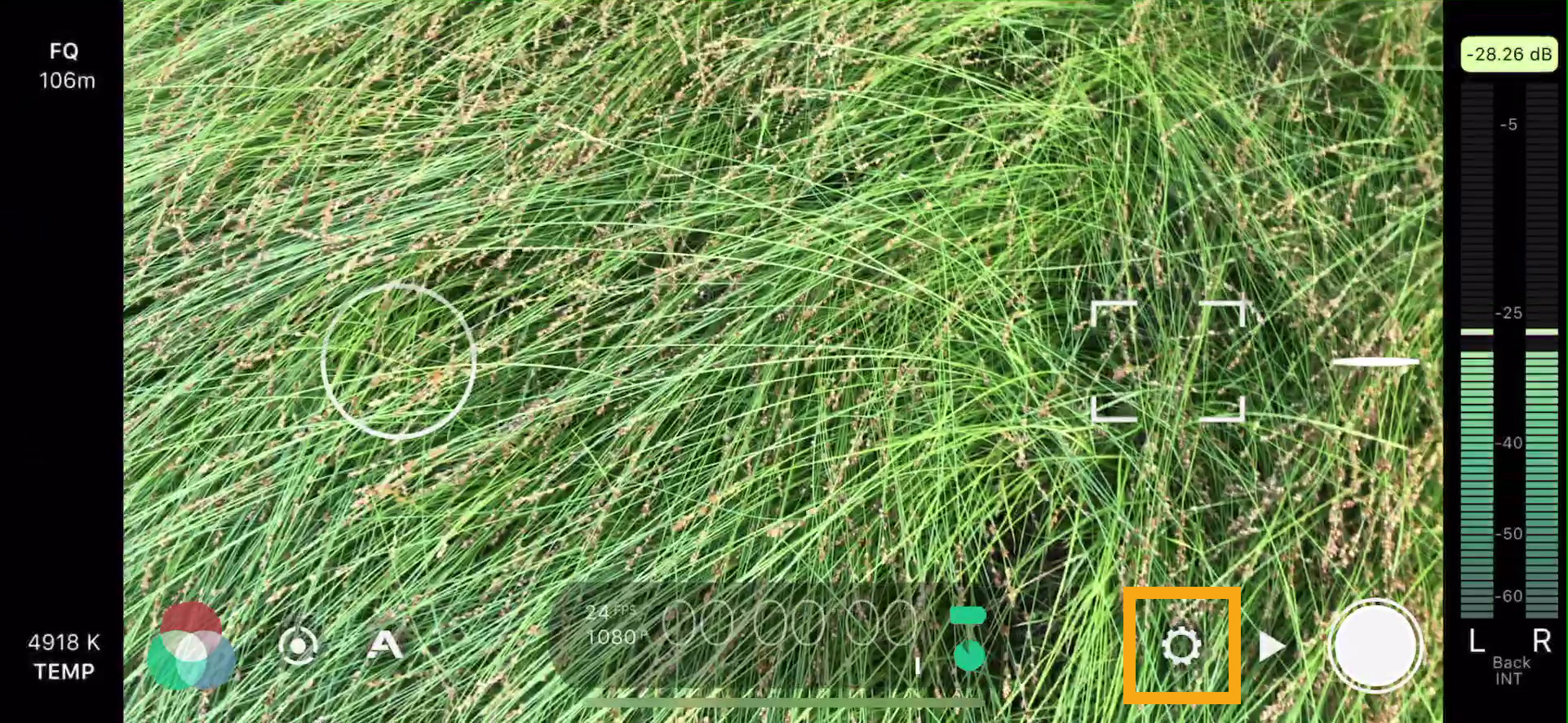
- Tap on "Device."

- Set "Save to Camera Roll" to OFF (its default setting.)
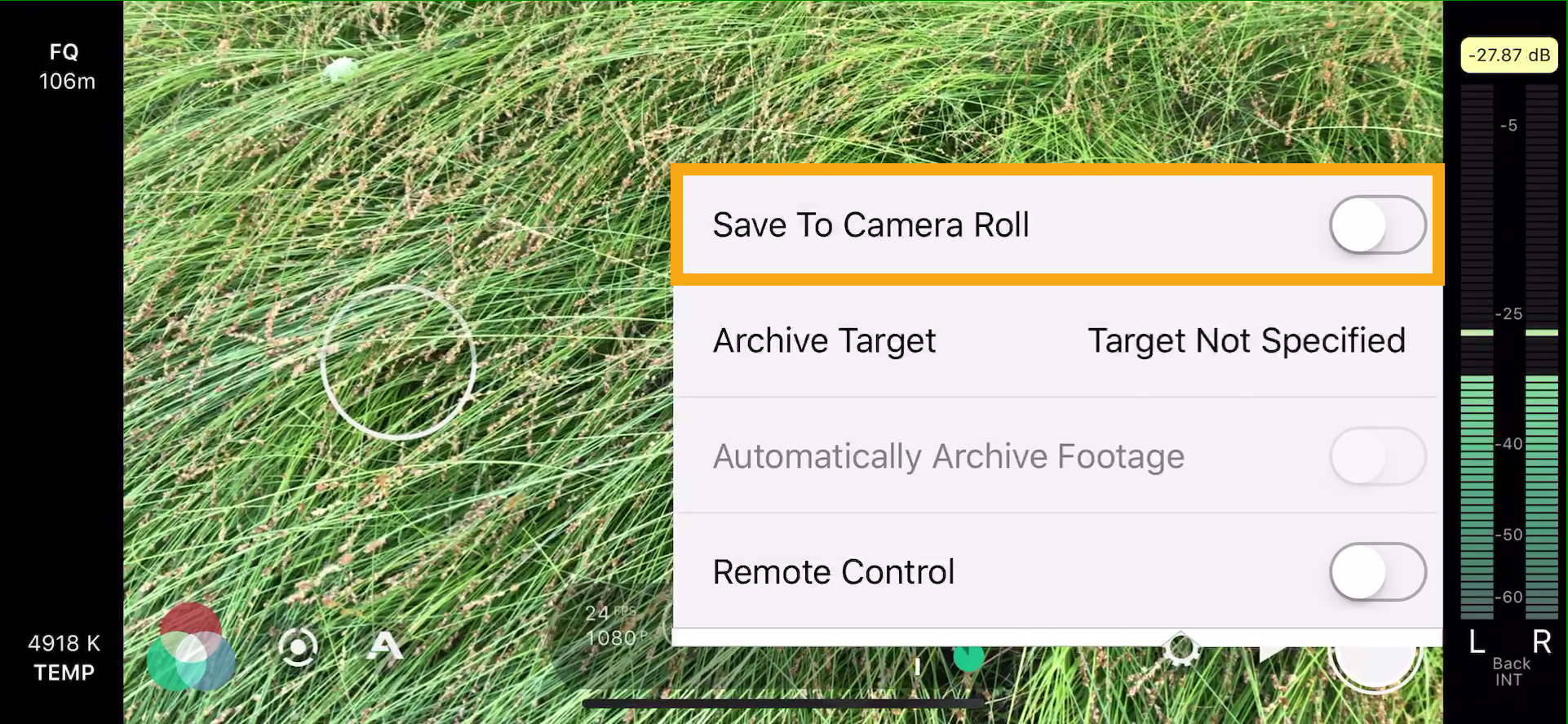
- Tap on "Archive Target," then tap on MYPASSPORT. Tap on "Storage." Tap on the folder you would like your videos saved to, then tap "select folder."
NOTE: FiLMiC Pro does not currently support folder creation on My Passport Wireless devices. If you would like to save content to a unique folder, as shown here, that folder must be created first via the My Cloud app.


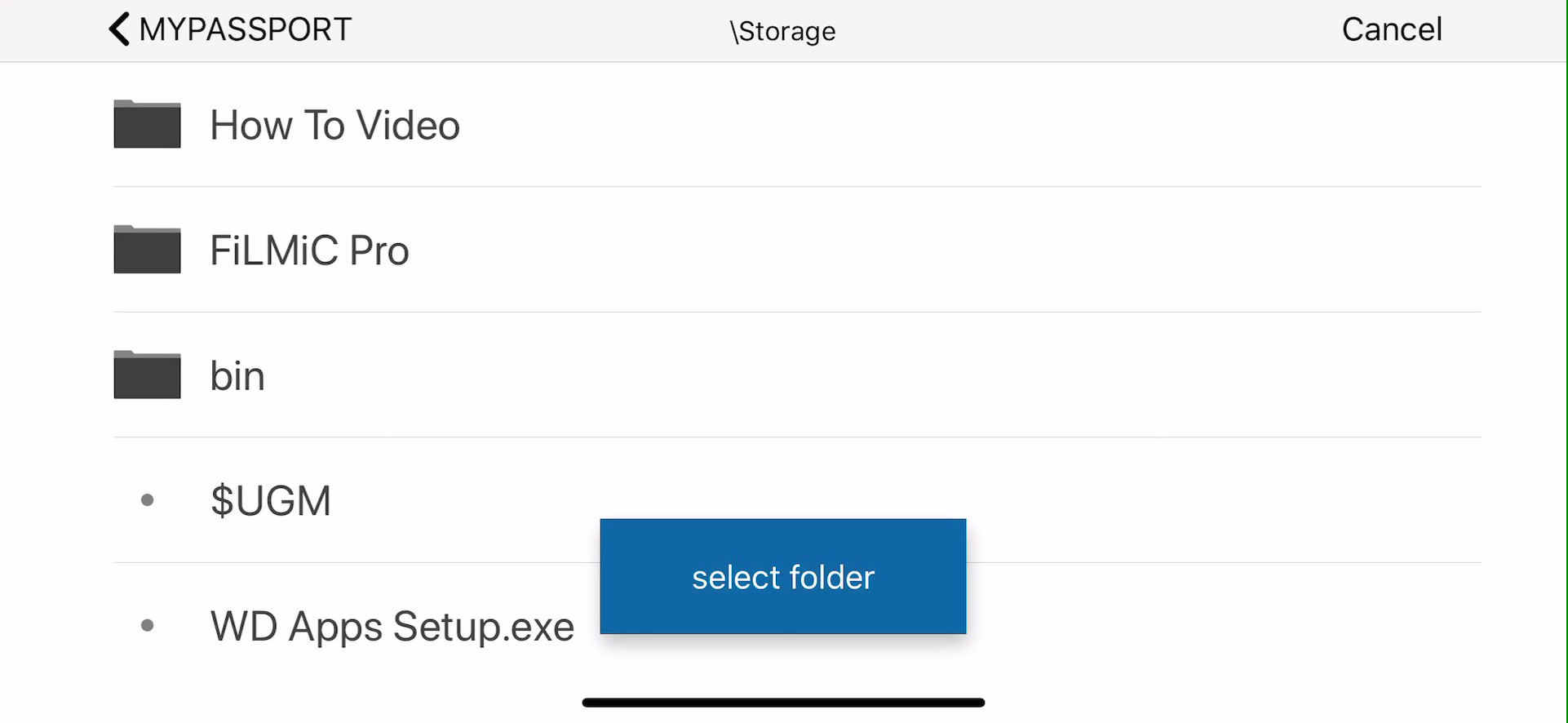
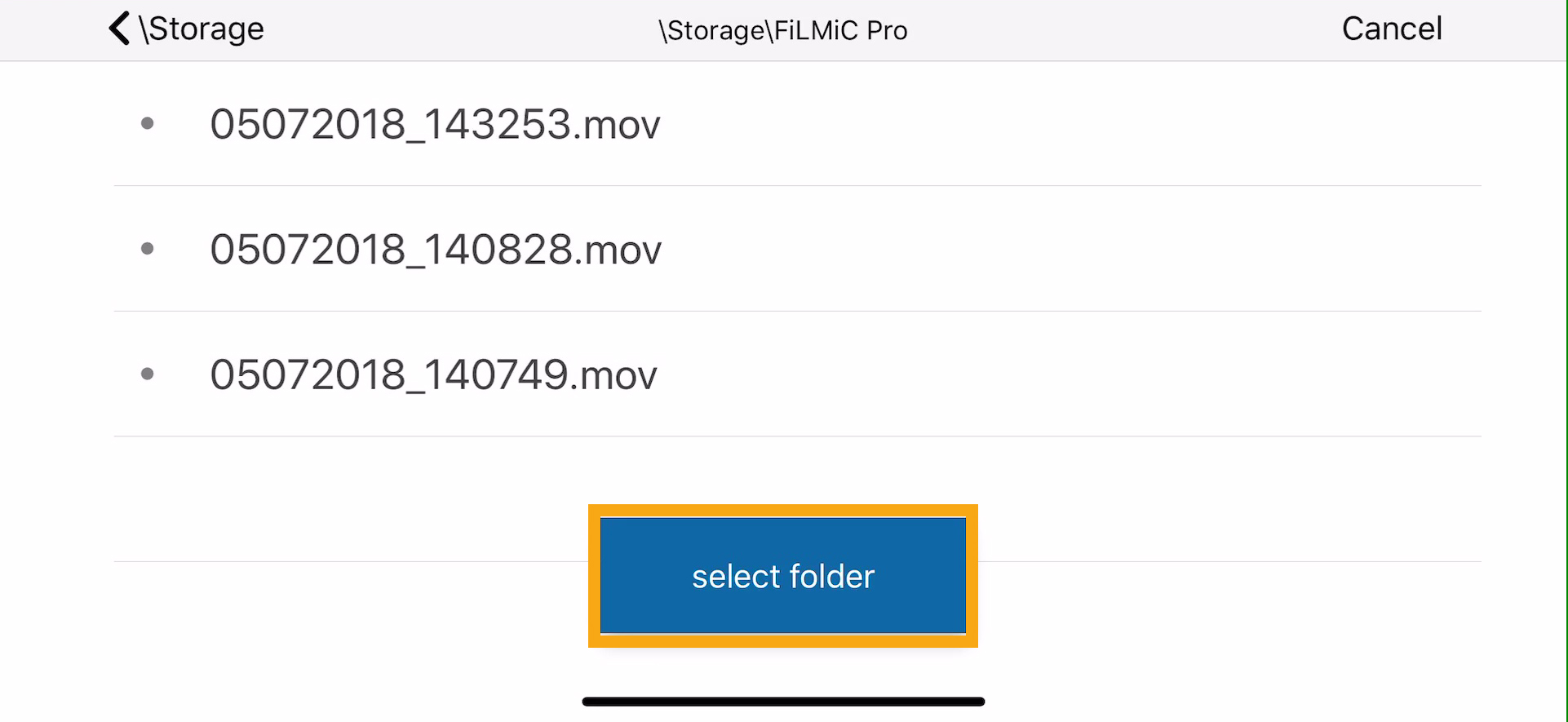
- Set "Automatically Archive Footage" to ON.

- se FiLMiC Pro as you normally would. As you record footage, the video is first saved to the internal memory of your iOS or Android device.
If you are wirelessly connected to a My Passport Wireless device, your video will be automatically copied in the background to the drive once you finish recording each take.
A notification will appear to indicate when archiving is complete.


- To see which videos have been copied as well as the progress of current backups, tap the play icon next to the gear icon.


-
How to wirelessly tether compatible Canon DSLRs
Compatible DSLRs: Canon 5D Mk IV; Canon 5D Mk III with WFT-E7A adapter; Canon 1DX Mk II with WFT-E8A adapter; Canon 1DX with WFT-E6A adapter
- Turn on the drive and connect to the "My Passport" network with iPhone, iPad or Android device.

- Set up the device with the My Cloud app, per the standard setup instructions. Once connected to the My Passport Wireless device, tap the settings icon.
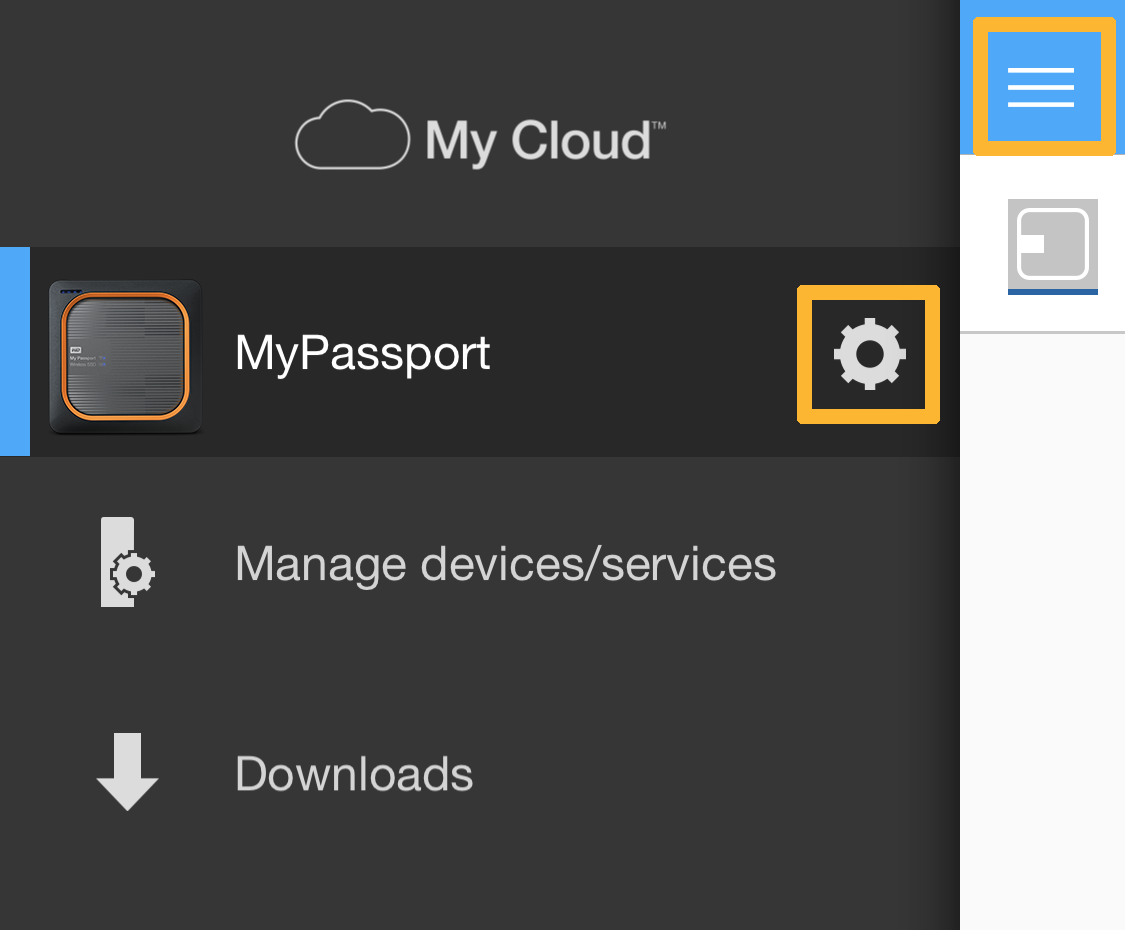
- Tap "More" in the upper right, then "Admin," and then set "FTP Access" to "On."
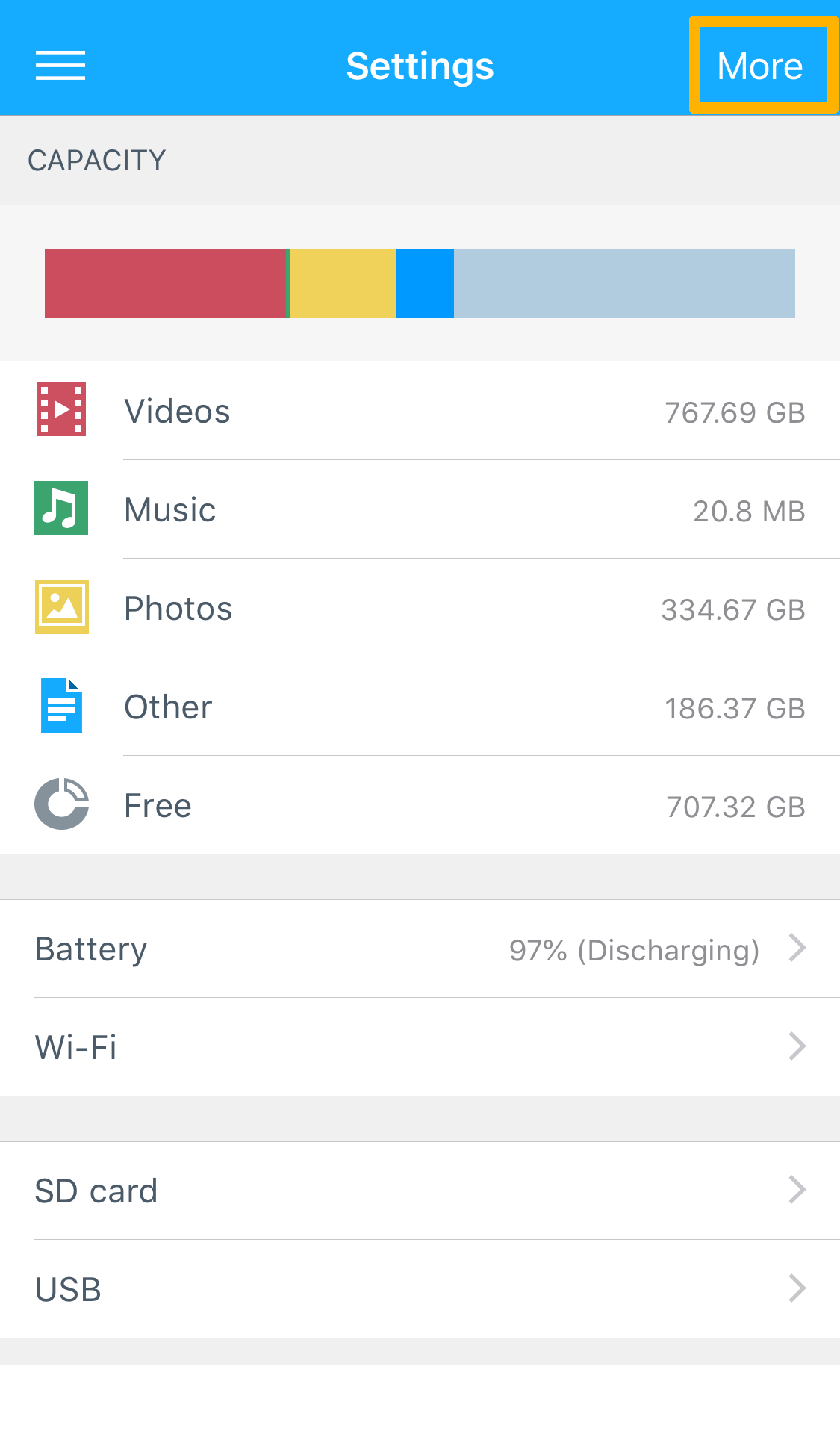

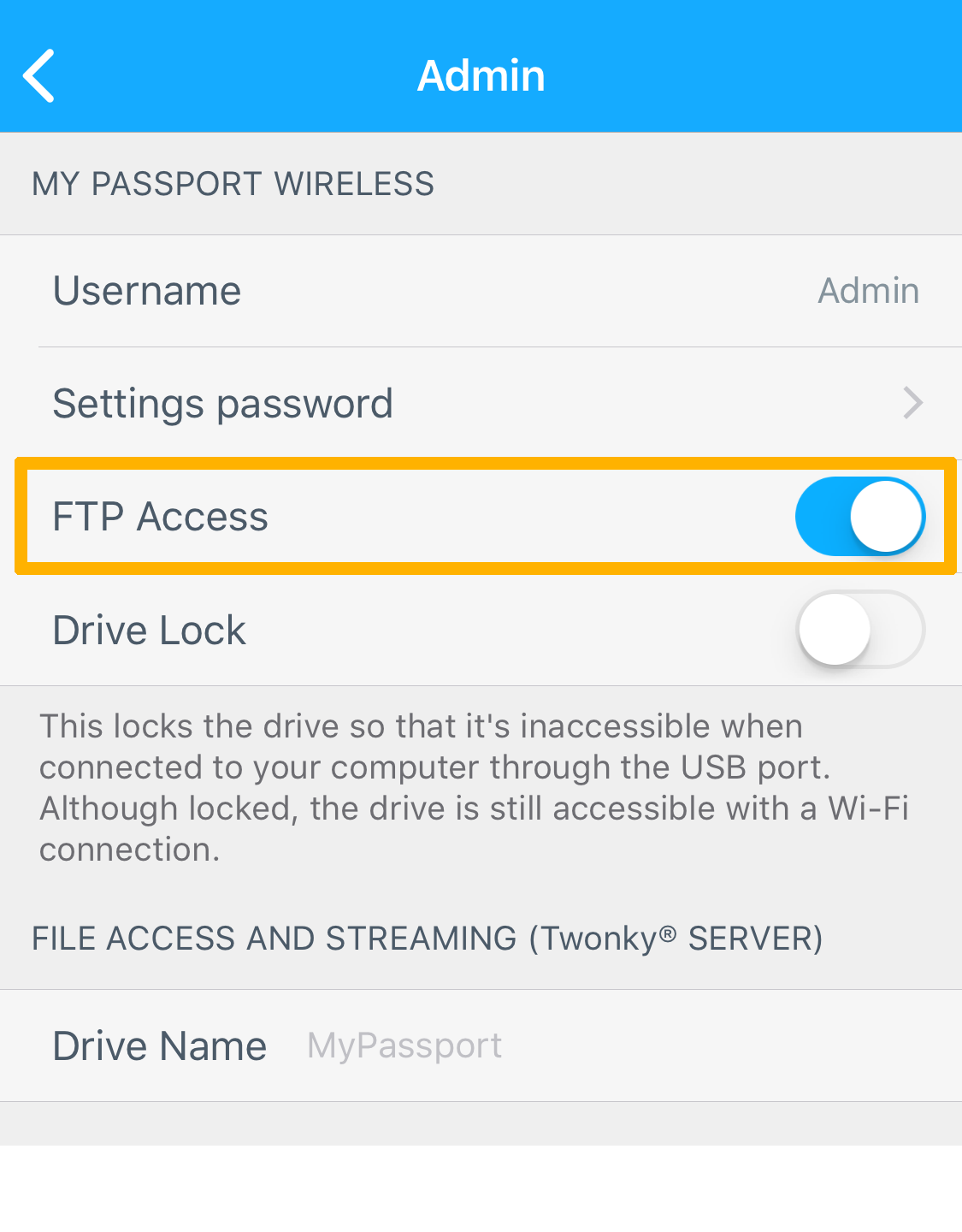
One-time Setup Instructions for Canon 5D Mark IV
Please observe these settings to configure other compatible Canon cameras that use a WFT adapter.
- Go to page 4 of wrench settings, and tap "Communication Settings".
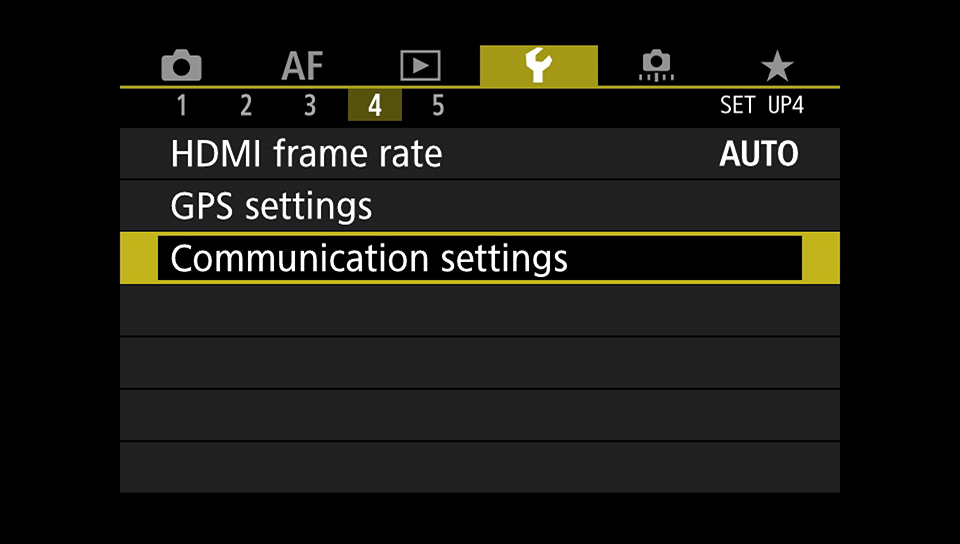
- Tap "Built-in wireless settings".
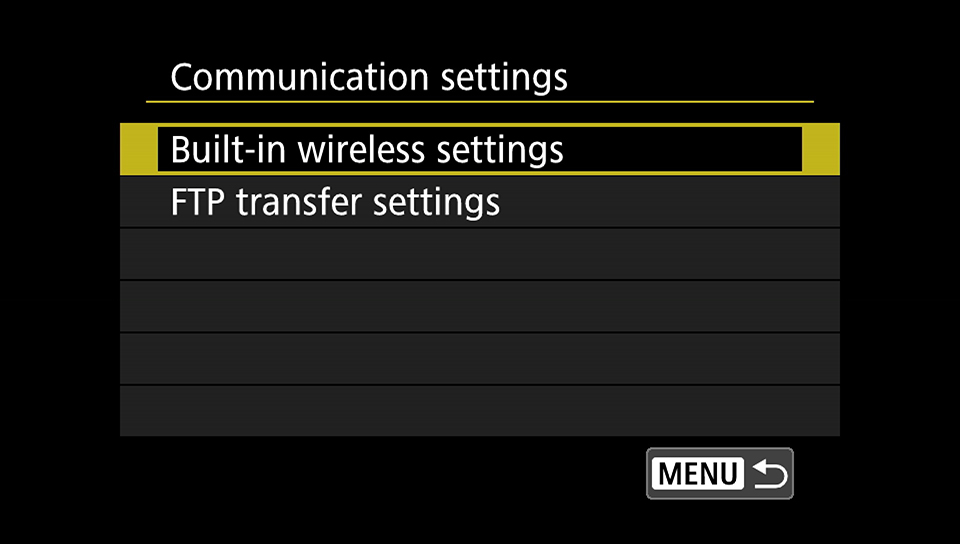
- Set "Wi-Fi/NFC" = "Enable".
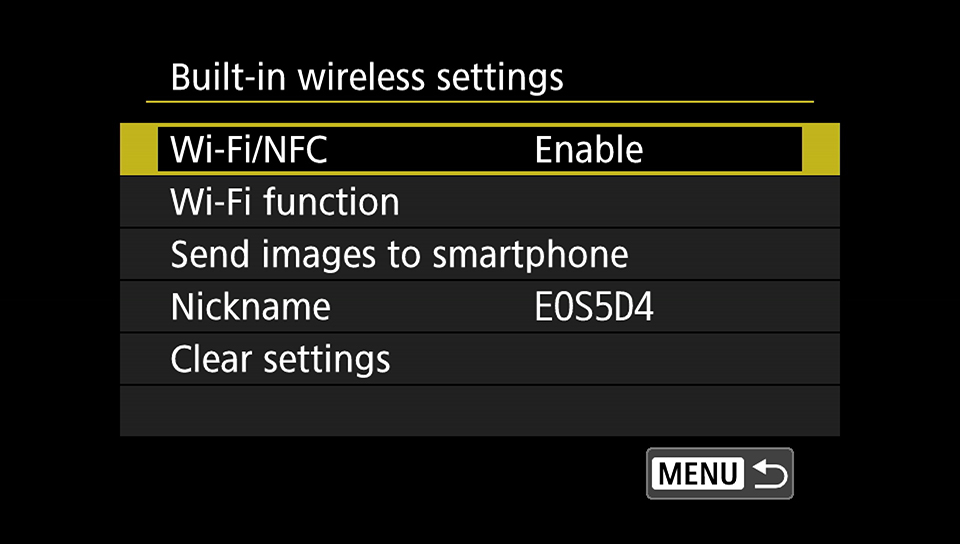
- Tap "Wi-Fi function", and then "Transfer images to FTP server".
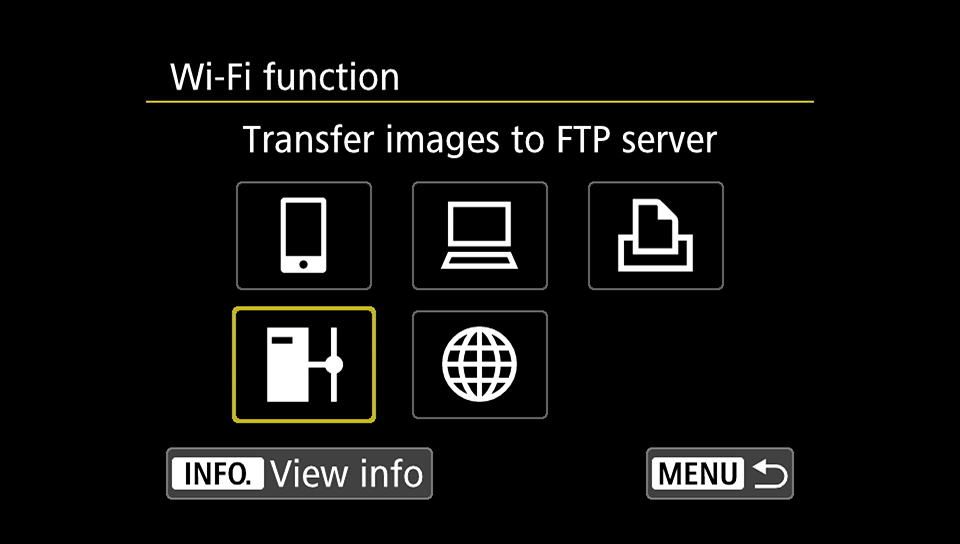
- Find the "My Passport" network, and type in the Wi-Fi password. (The default password is printed on the sticker that comes on the face of the drive.)
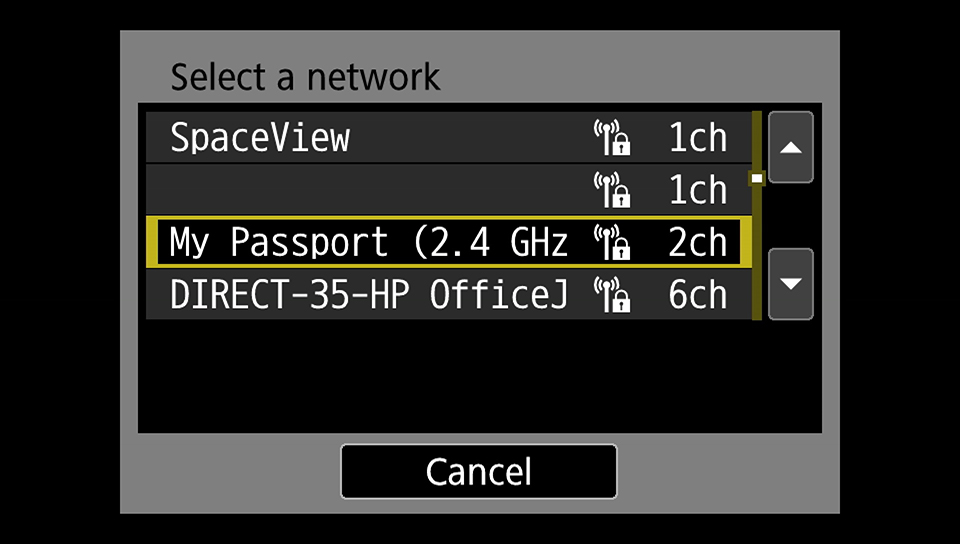
- Use the default options on the next 2 screens:
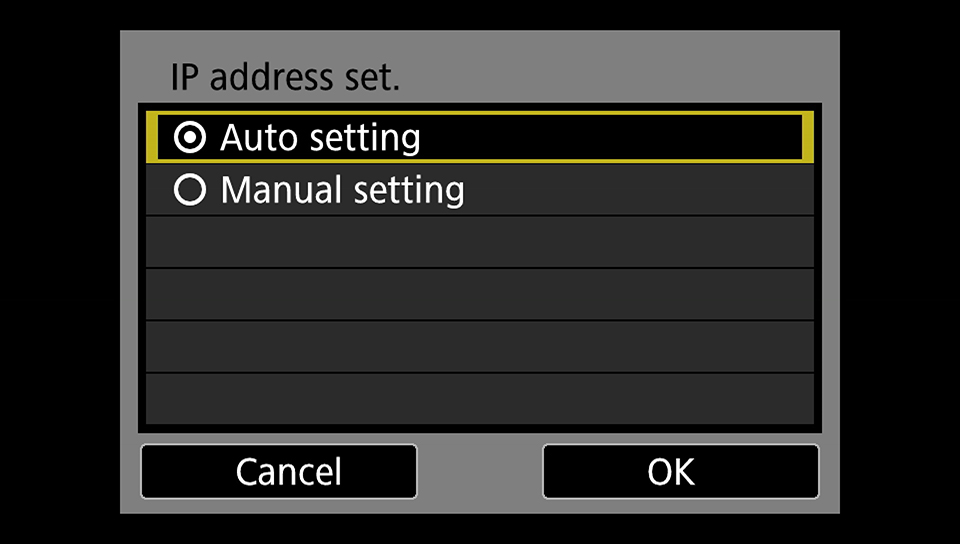
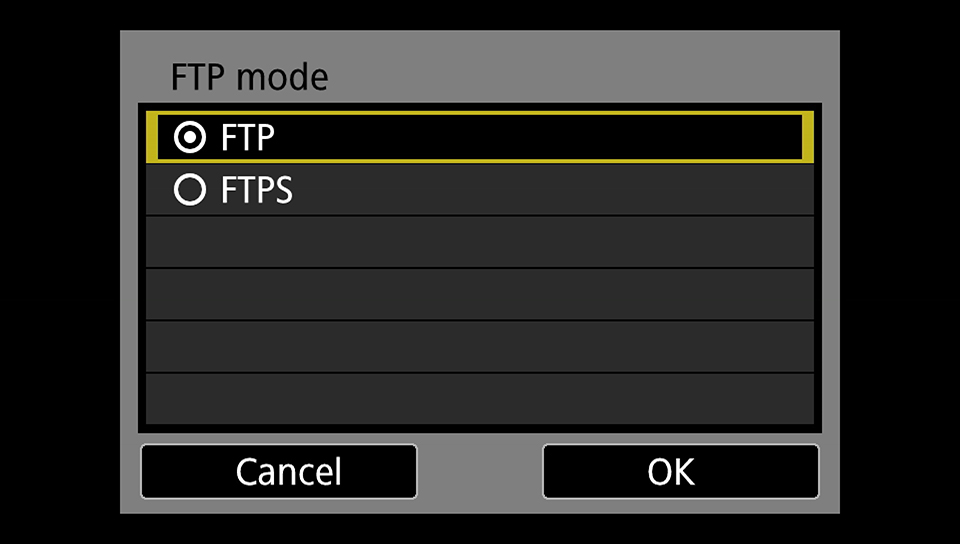
- On the FTP server screen, tap on "Address setting" and change the "Server name" to 192.168.60.1. Leave port number as 00021.
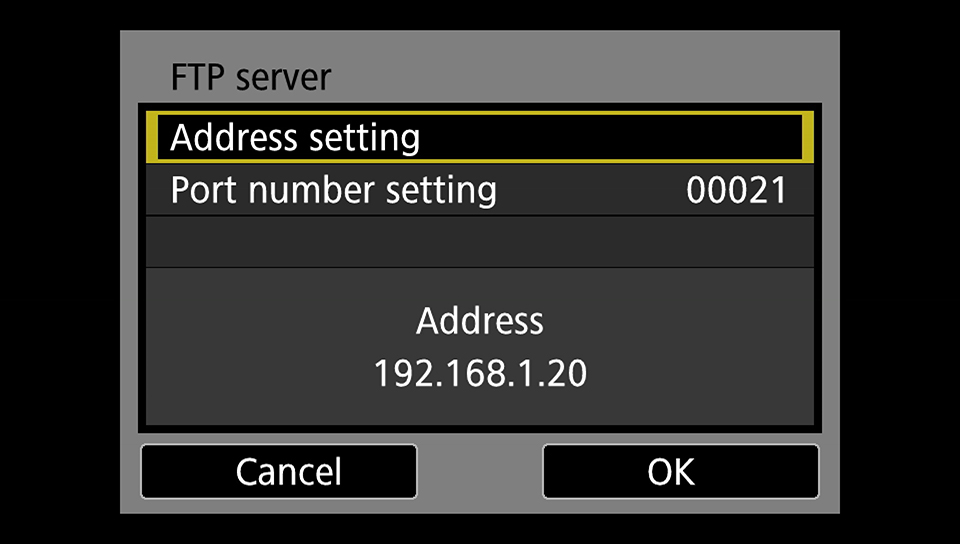
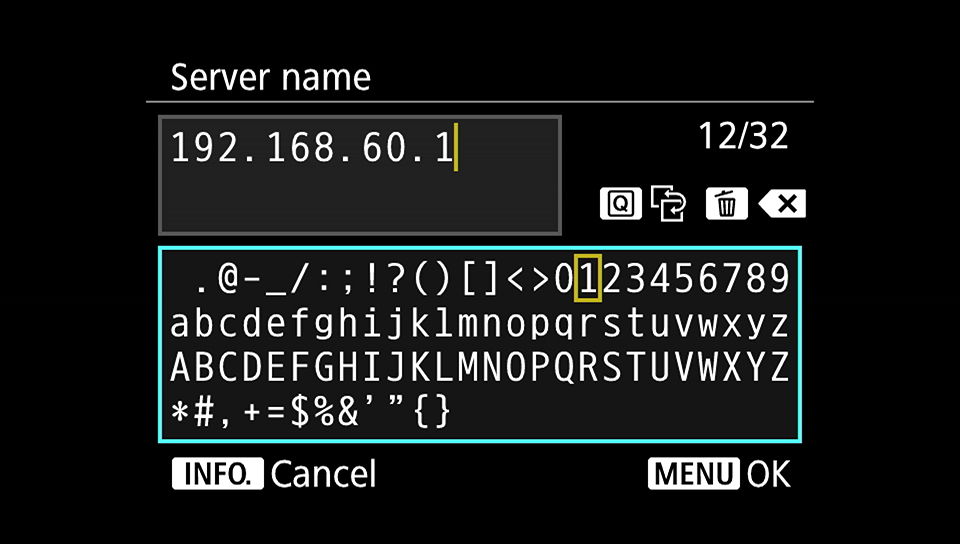
- Use the default options on the next 3 screens:
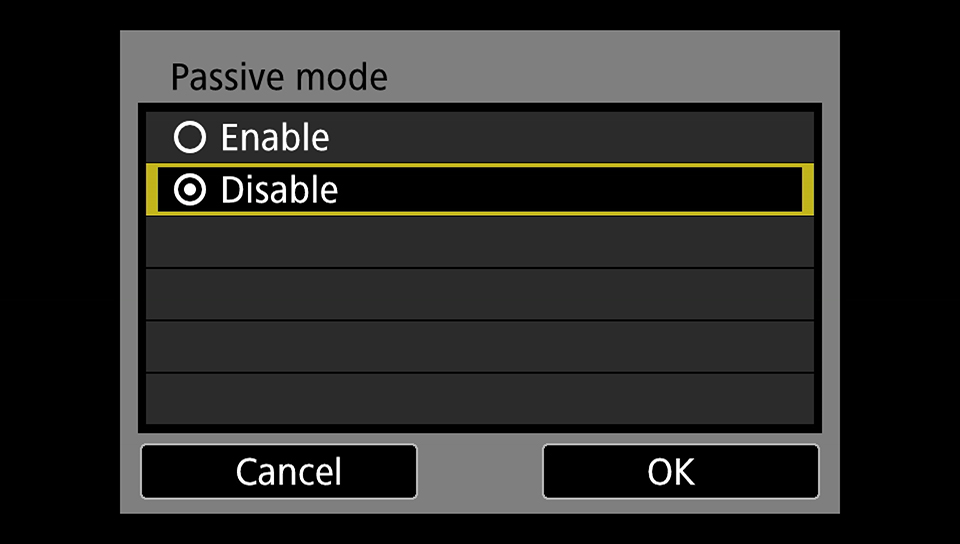
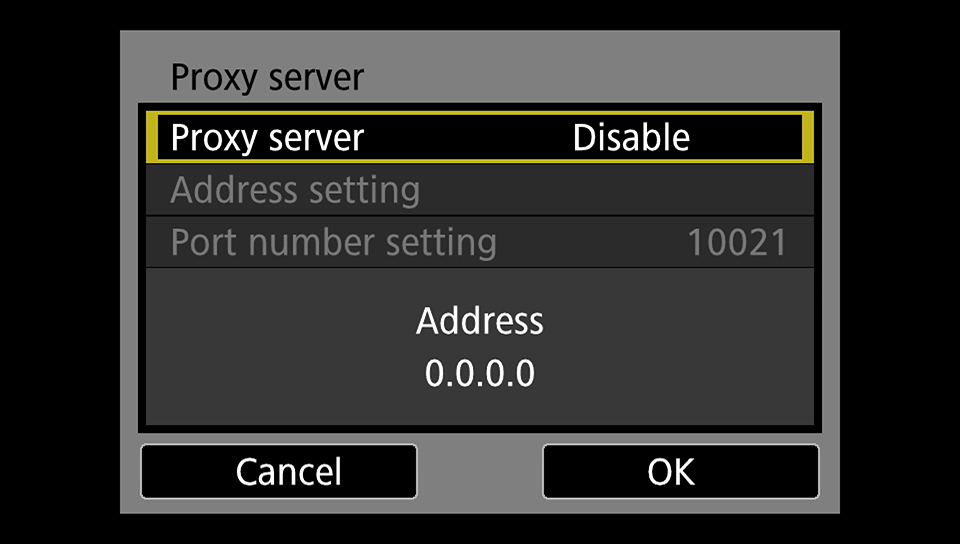
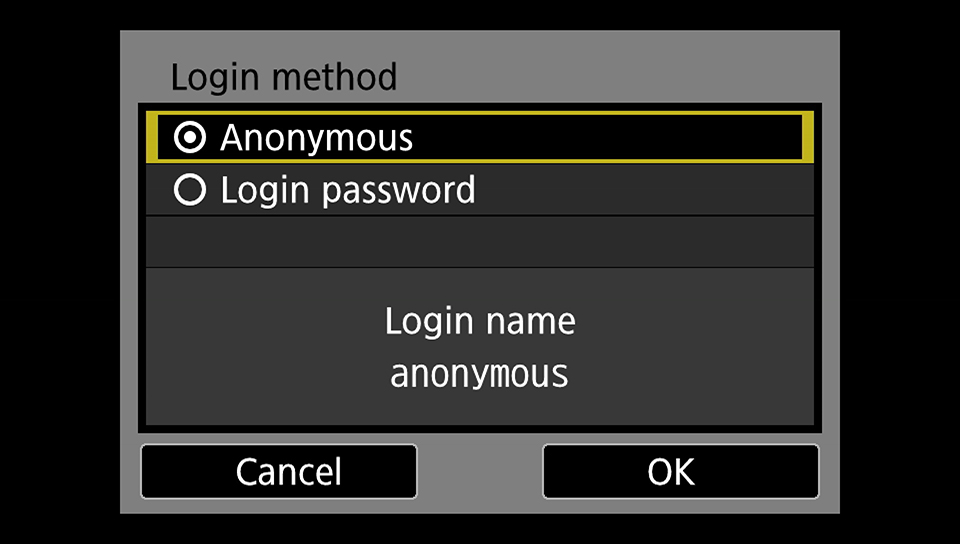
- On "Target folder," tap "Select folder". Type in "/Storage/" and a folder name. "Storage" is case sensitive and must be typed exactly as shown.
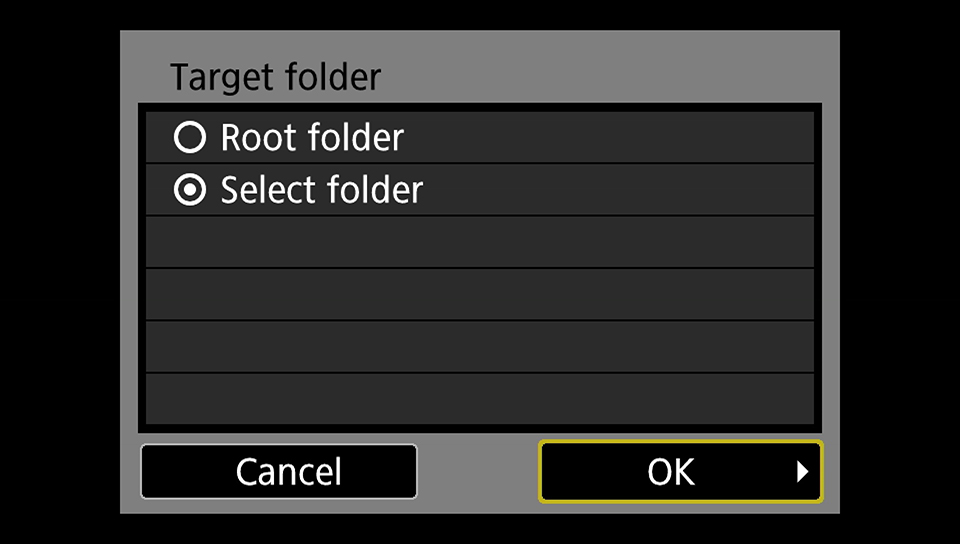
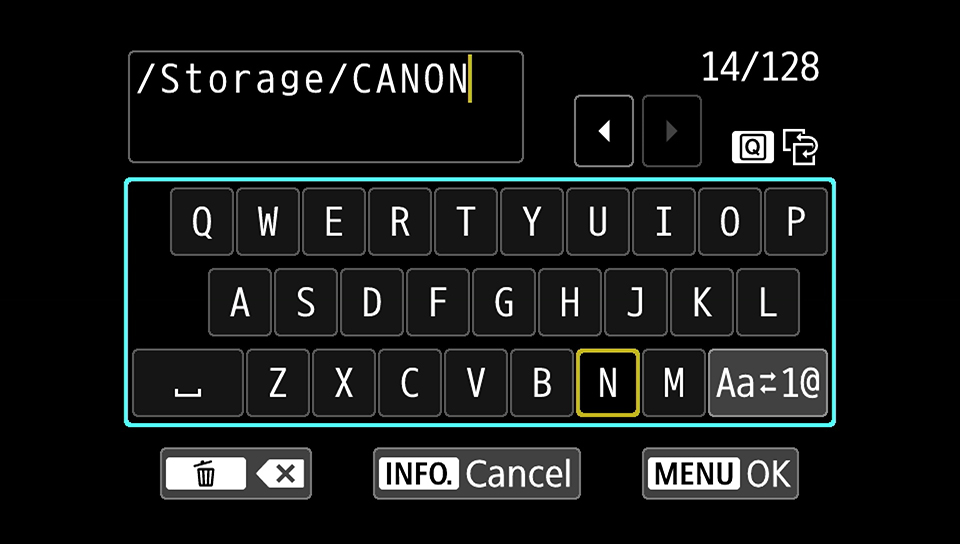
- If you receive an error, ensure no typos in steps 7 and 9. When both are powered on, the drive and camera will now automatically connect to each other.
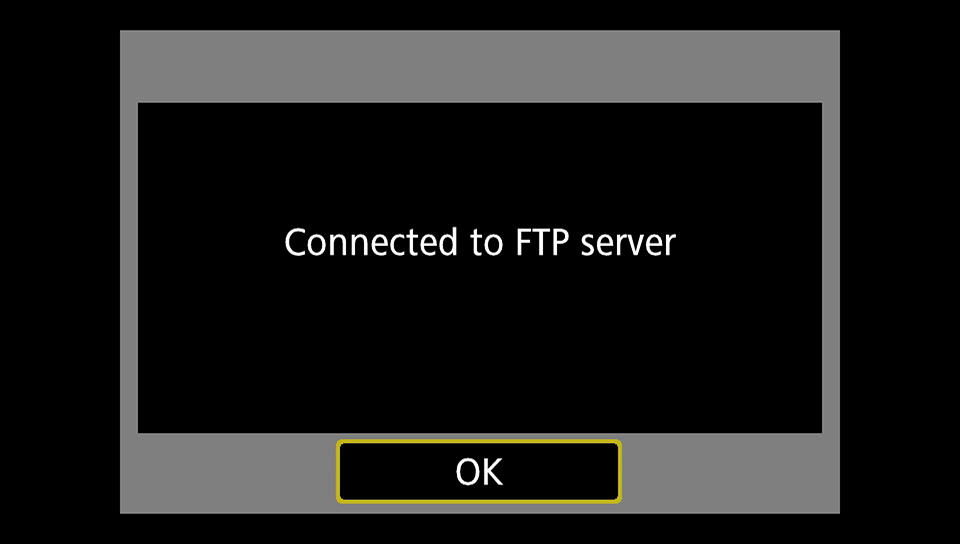
- To set up automatic wireless backup, return to the screens in steps 1 and 2.

Tap on "FTP transfer settings"
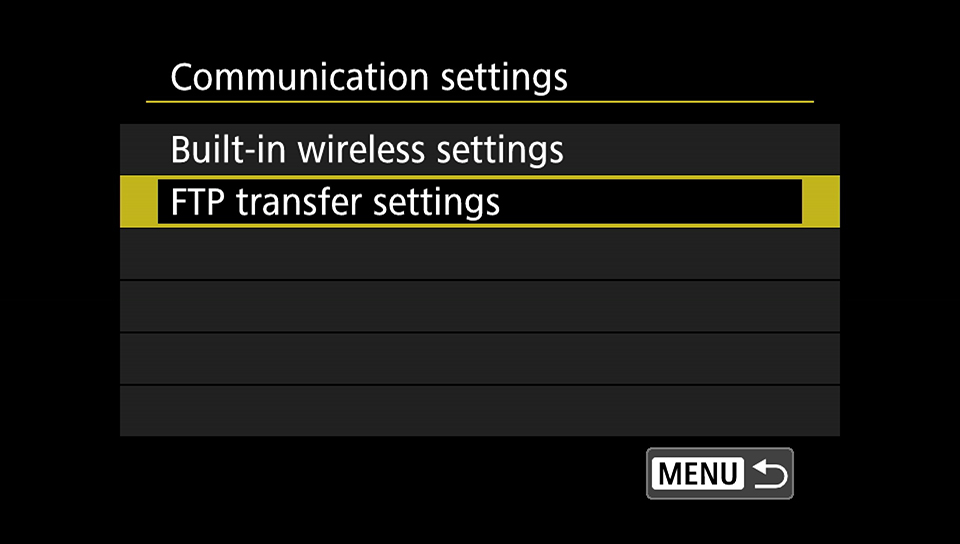
You can use any of the default options on the "FTP transfer settings" screen. However, we recommend always setting your camera to shoot RAW+JPEG to the card(s) inside the camera, with full-resolution RAWs and then a JPEG of lower resolution. We set "Transfer type/size" in "FTP transfer settings" to "JPEG only" for RAW+JPEG transfer, to get fast JPEG previews sent to the drive, while keeping RAWs saved to the card.

- Connect to your My Passport Wireless' Wi-Fi network from your iPhone, iPad, or Android device, and use WD's free My Cloud app to access and preview your images anywhere. No internet connection or laptop needed.
- Turn on the drive and connect to the "My Passport" network with iPhone, iPad or Android device.
-
How to wirelessly tether compatible Nikon DSLRs
One-time setup instructions for My Passport Wireless SSD or My Passport Wireless Pro
- Turn on the drive and connect to the "My Passport" network with iPhone, iPad or Android device.

- Set up the device with the My Cloud app, per the standard setup instructions. Once connected to the My Passport Wireless device, tap the settings icon.

- Tap "More" in the upper right, then "Admin," and then set "FTP Access" to "On."



- Click back to the My Passport Wireless drive, then tap on "Storage" in the main window.
You will need to create a folder for the camera to send the images to. Create a new folder; for this tutorial, we named the folder "NIKON D850."
To add a new folder with the My Cloud app for iOS/Android, tap the three dots in the menu bar, then tap "New folder":

The new folder should appear under the "Storage" header, as seen here:

- Turn on the drive and connect to the "My Passport" network with iPhone, iPad or Android device.
-
Setting up Nikon D850 cameras with WT-7/WT-7A adapters to allow tethering with the My Passport Wireless devices
One-time setup instructions using the connection wizard
Please observe these settings to configure other compatible Nikon cameras that use a WT adapter. To view instructions for manual setup, click here.
- Push the menu button and navigate to the Setup Menu (with an icon of a wrench).
In this menu, scroll down to and tap on "Network."

- In the "Network" page, first tap "Choose hardware" and select "Wireless LAN."



- Tap "Network settings," then tap "Create profile."

Next, tap "Connection wizard."

- Tap "FTP upload", then enter a name for the network profile.

The default is "WLAN," but we've renamed it to "WD" here.

- On the next screen, tap "Search for wireless network".

Select the 5 GHz version of the "My Passport" network. This is the option that will give you the fastest transfer speeds as long as the drive is within 1-2 meters of your camera.

Enter the Wi-Fi password for the My Passport Wireless. (The default password is printed on the sticker that comes on the face of the drive and is present in the quick start guide in the original box. For more information on finding the default password, click here: Default Wi-Fi password on a My Passport Wireless Pro and SSD.)

If you entered your password correctly, you will be presented with the following screen:
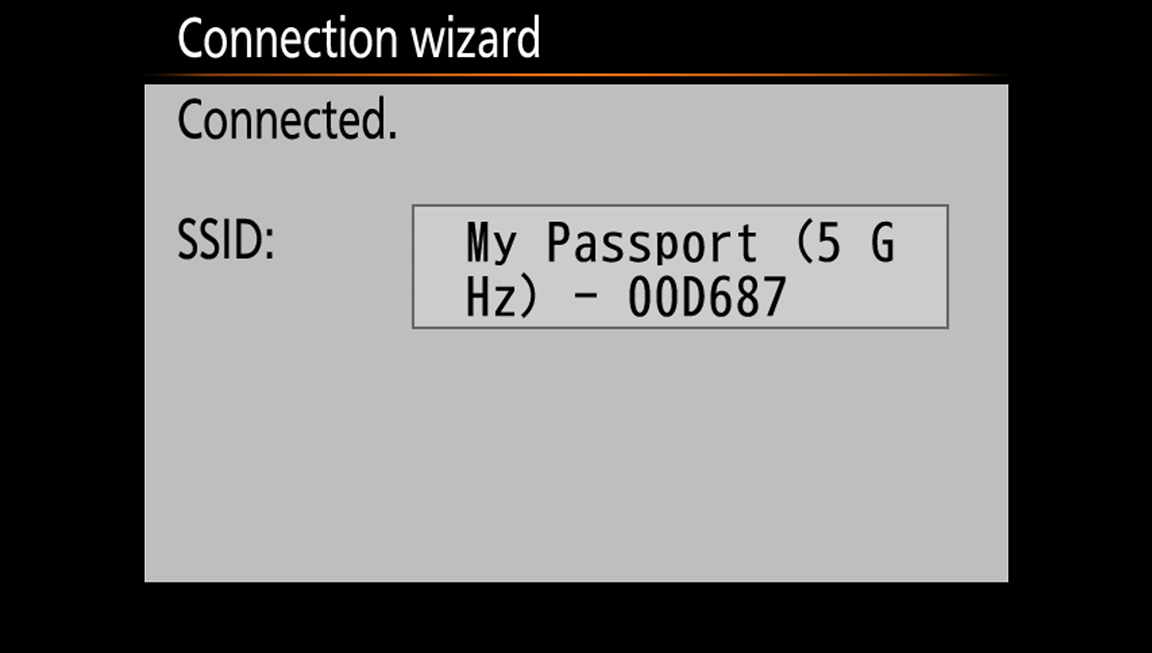
- On the next screen, click "Obtain automatically."

And you will be presented with the following settings. Your exact IP address may differ from what is shown below.

- On the next screen, click "FTP".

Enter the FTP server address exactly as shown : 192.168.60.1

Click "Anonymous login" for the FTP server login method.

- Click "Enter folder name".
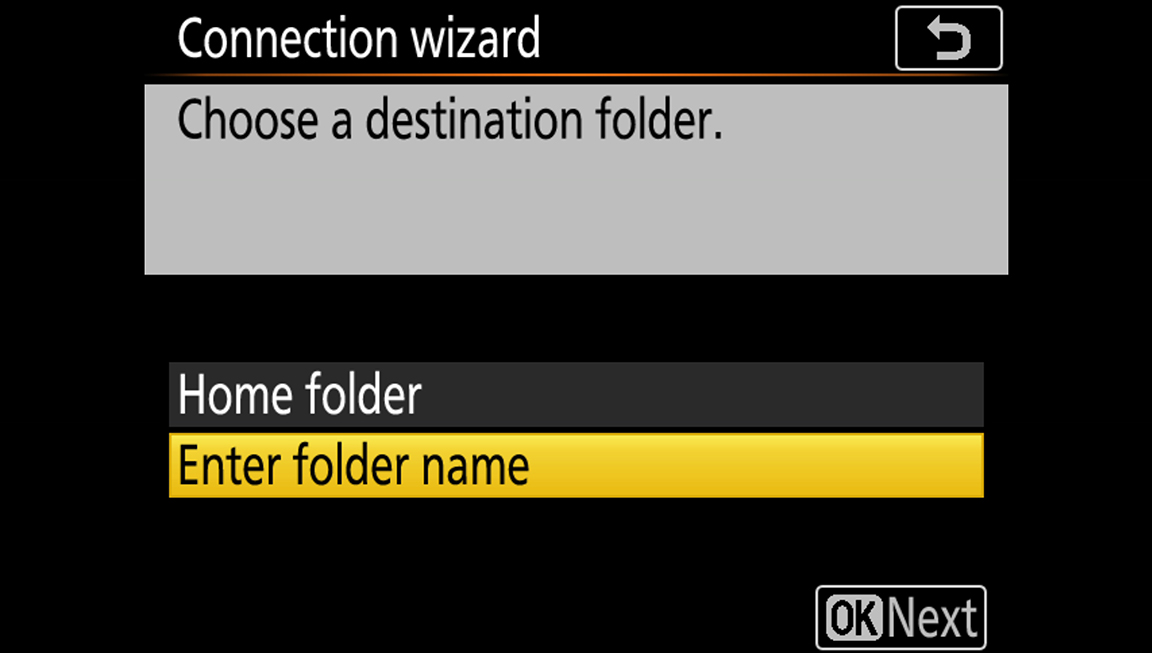
Recall the new folder you created in step 4 of the setup instructions for your My Passport Wireless drive.
Type in Storage/ and then that folder name exactly as you typed it when creating the folder in the My Cloud app.
Any mis-typed or omitted characters here will result in errors that will cause the wireless tethering experience to fail. Because we named our folder "NIKON D850" earlier, we will type in Storage/NIKON D850
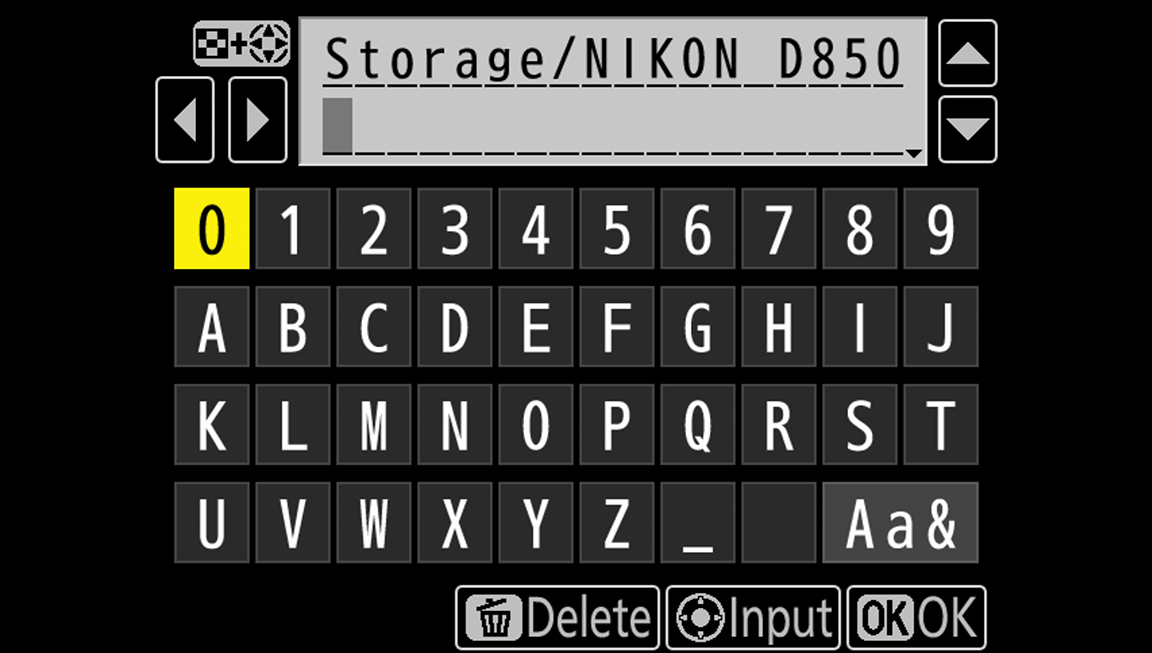
After clicking "OK", the confirmation screen may truncate your folder name. As long as you entered it correctly before, this truncation will not affect your experience.
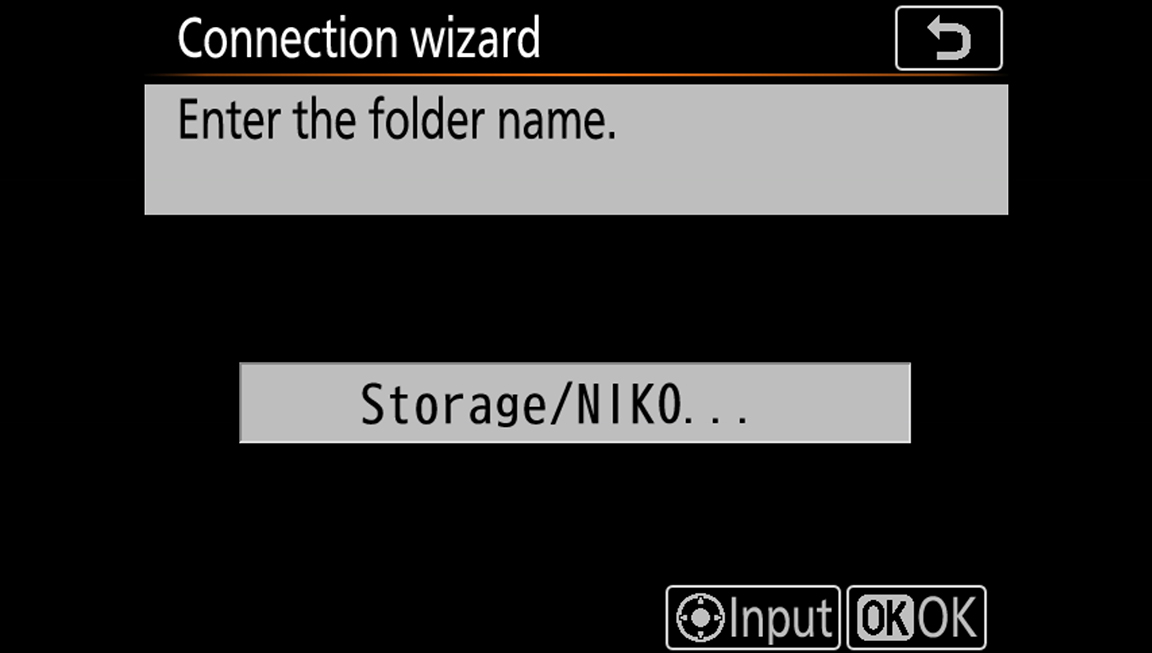
- If you completed all steps above correctly, you will be greeted with the following screen. Click "Connect and exit wizard."

- On the following screen, you should see the name of your network profile (from step 4 of the Nikon setup) in green highlight, as well as information on signal strength and battery life remaining in your wireless adapter.
Click on "Options."

- We like to set "Auto send" to ON. As you shoot photos on your Nikon camera, this setting will automatically send those images from the memory card to your My Passport Wireless.
Note that there is also an option here to "Delete after send." This setting will delete the image from your card after it is sent to the My Passport Wireless. While this will help preserve space on your memory cards, we recommend keeping this setting turned to "OFF" as we always prefer to have a backup versus a single copy of our work when we are in the field.
"Send marking" will add metadata to the image file of the date/time of upload to the My Passport Wireless. It can be set OFF or ON, without impacting the overall experience.
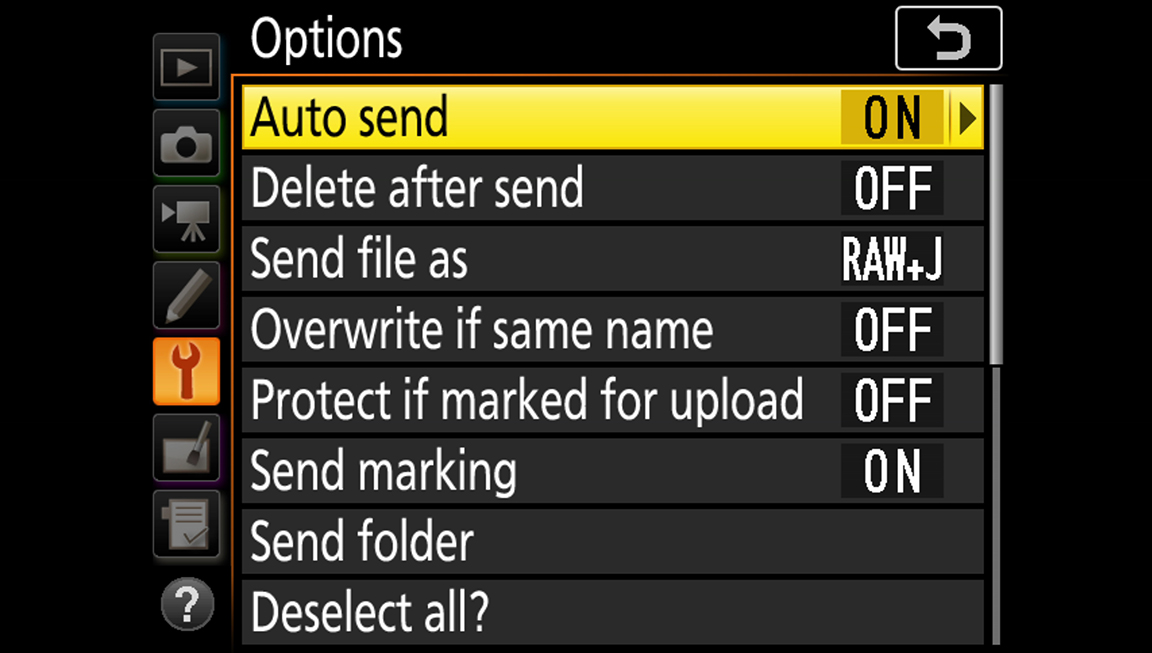
In "Send file as," we recommend the option best suited for your use case. For easy, card-free backups as you shoot, we recommend "RAW+J." Note that, because this will send more data in each transmission, it may deplete the battery life of your camera and/or wireless adapter and My Passport Wireless more quickly.
If you are shooting rapid succession burst mode and are looking to use this feature for quick, mobile-ready full screen previews of your composition, then "JPEG only" may be sufficient of you.
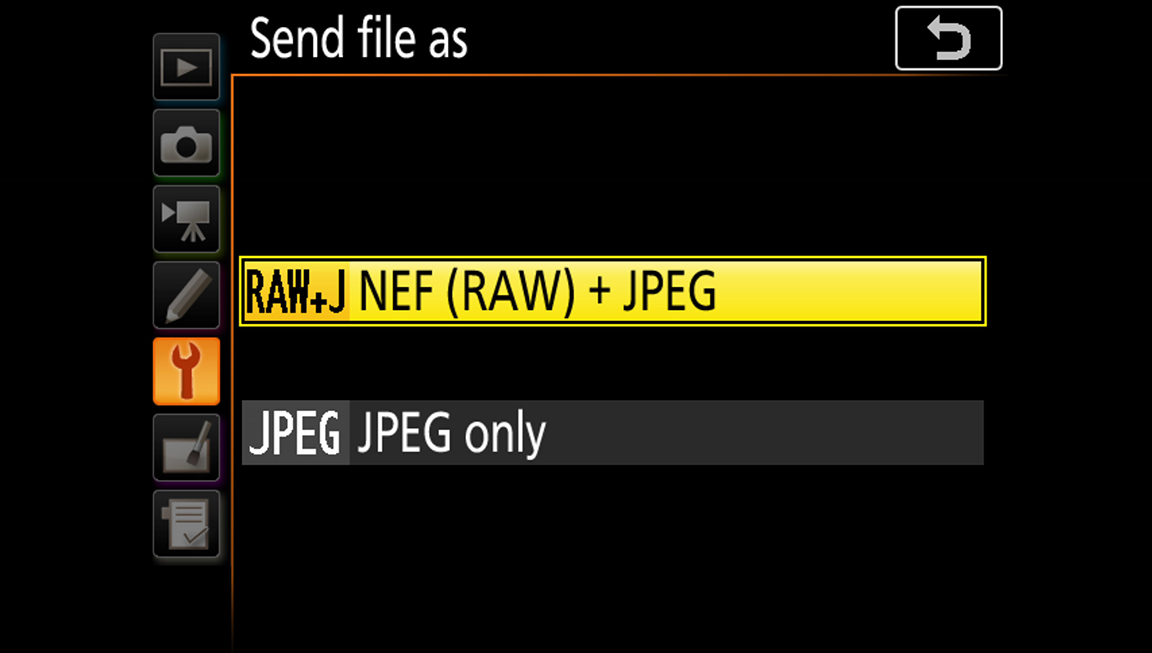
Scrolling further in the "Options" menu reveals additional settings.
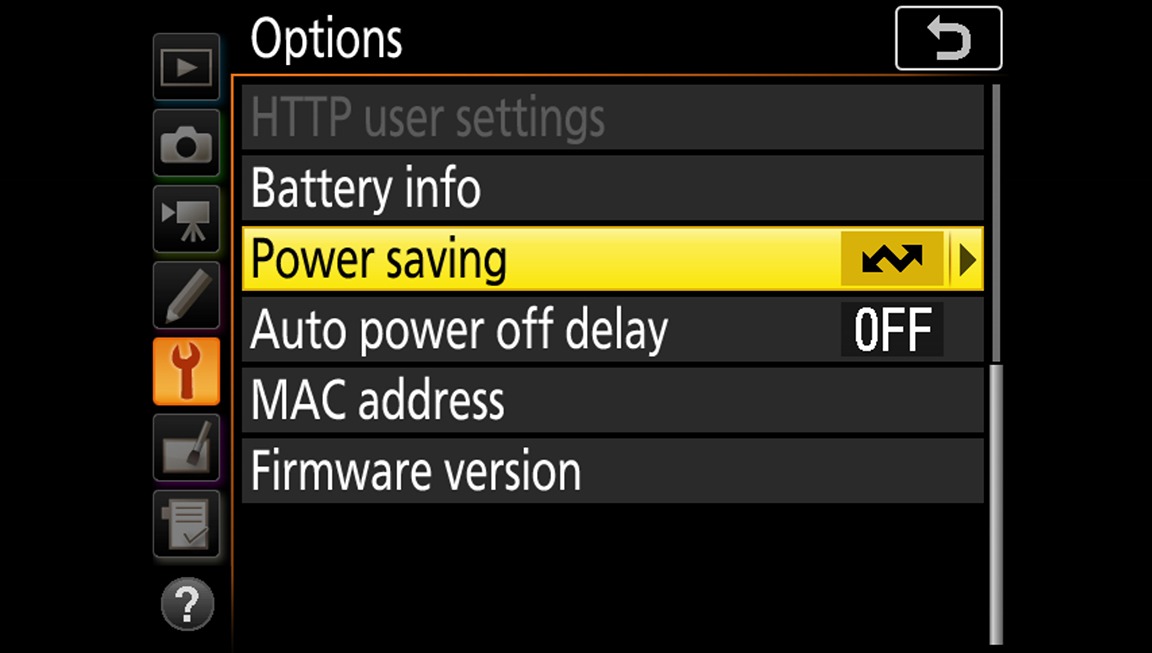
On "Power saving," for the highest-speed performance, we recommend "Prioritize network speed." If long battery life is critical and slower transfer speeds are acceptable (such as during time lapse photography, capturing in single shot mode, etc.), then "Prioritize power saving" may help extend the battery life of the batteries in your camera and/or wireless adapter.

We also set "Auto power off delay" to "No limit" to ensure the camera and wireless connection are always ready.
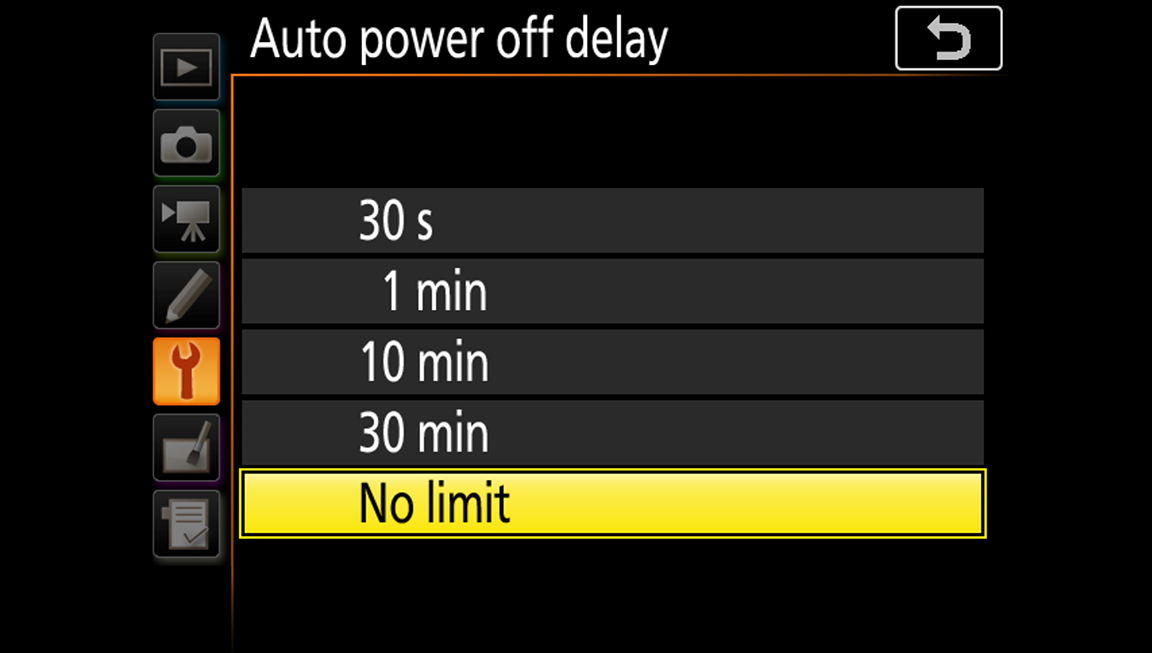
- As you take photos while wirelessly tethered to a My Passport Wireless, you may click back to the "Network" menu to now see transfer status, including name of file currently being sent and number of photos remaining to be sent (in the lower left corner). In our experience, the timer in the middle tends to over-estimate the total time needed to transmit all photos in the backlog.

If connection is lost between the Nikon camera and the My Passport Wireless (due to leaving the wireless range or a shutdown of the drive), the Nikon camera will display the name of your profile (from step 4) in red and will show a "Wireless error" message in this section. However, the backlog will be maintained; simply turn the Nikon camera off and then back on and re-power and/or bring the My Passport Wireless back in range of the Nikon camera, and they will reconnect automatically. The Nikon will then resume transmission of any remaining images in the backlog, as well as new images that you shoot from then onwards. - Connect to your My Passport Wireless drive's Wi-Fi network from your iPhone, iPad, or Android device, and use WD's free My Cloud app to access and preview your RAW and JPEG images anywhere. No internet connection or laptop needed. Click here to download for iPhone/iPad or here for Android.
One-time manual setup instructions
If you prefer to setup Nikon camera and WT accessory with My Passport Wireless SSD manually (and not via the Nikon wizard), follow these steps:
- At the beginning of the manual setup process, there will be 4 items to configure: General, Wireless, TCP/IP, and FTP.
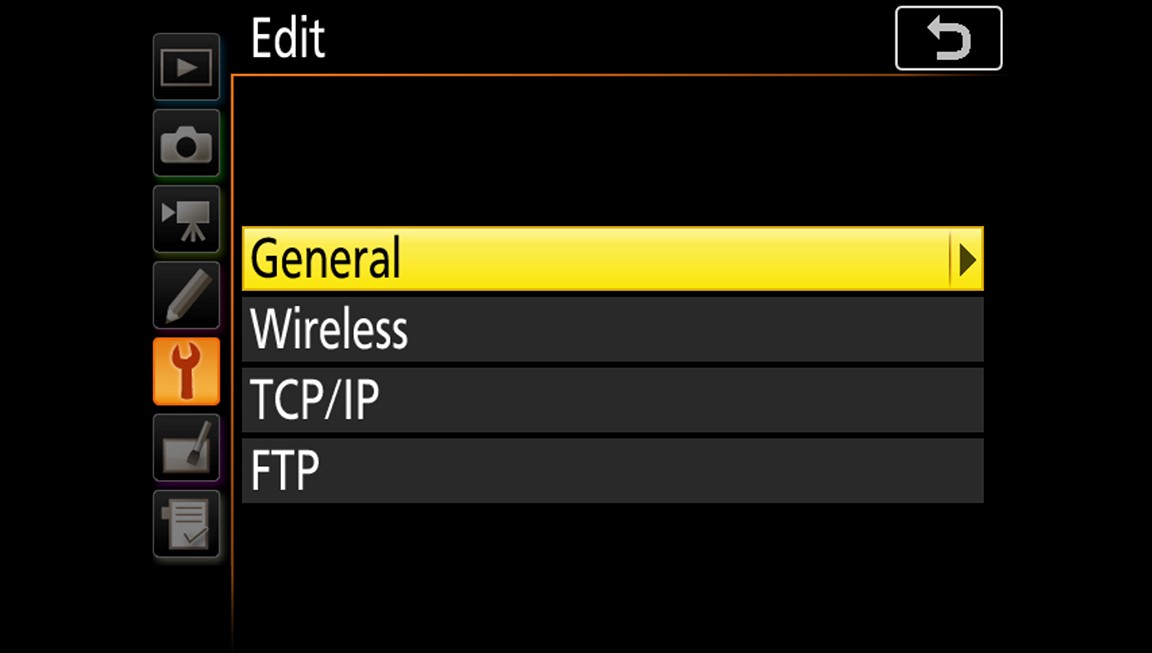
- In "General," you may change the profile name. We set "Password protection" to be "OFF."
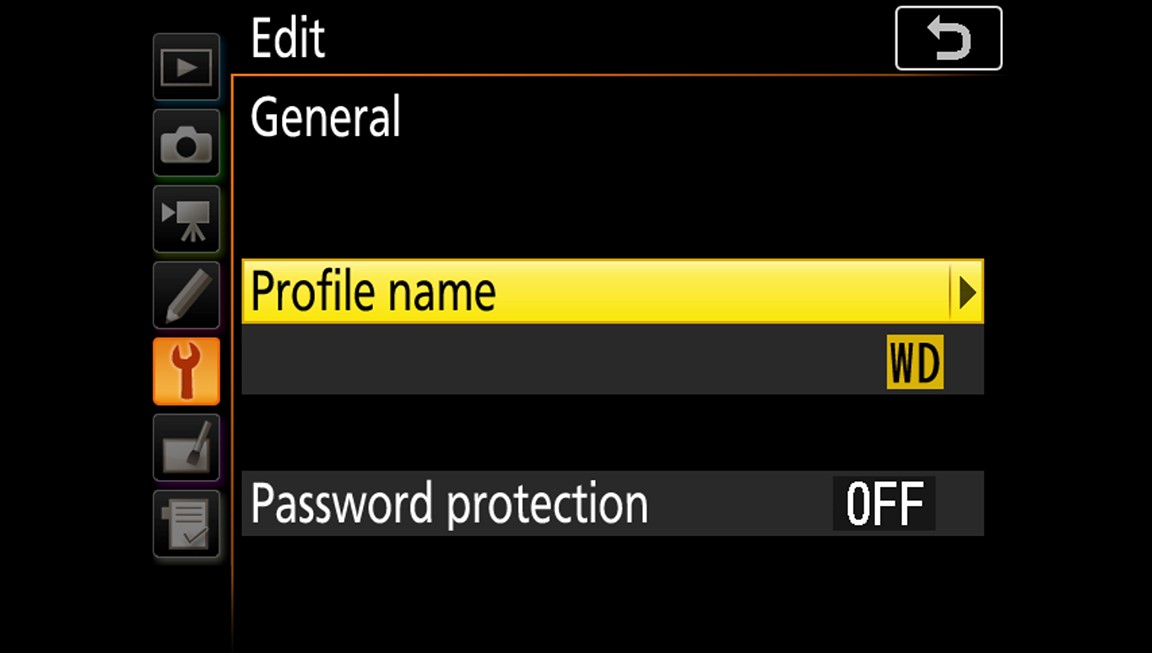
- In "Wireless," enter the network name exactly as it appears in your smartphone or tablet's "Wi-Fi" settings. Be aware of case sensitivity and spaces. (For this step, you may wish to change the Wi-Fi SSID of the My Passport Wireless drive to something shorter – please refer to the user manual for instructions)
Set communication mode to "Infrastructure."
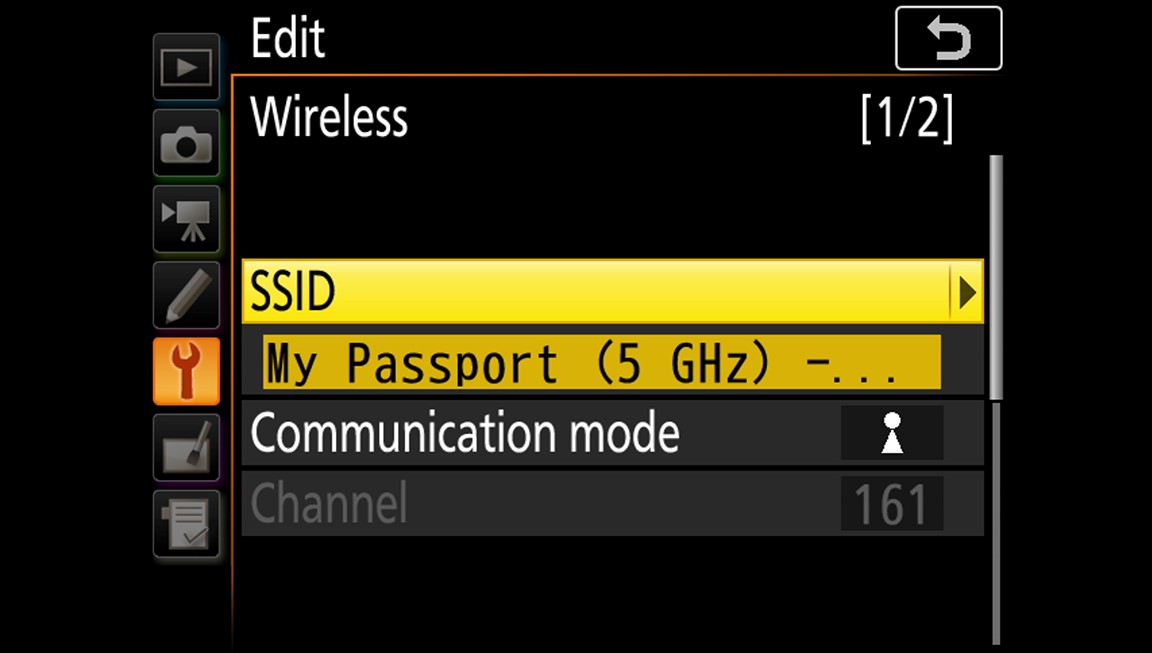
Set "Authentication" to "WPA2-PSK", and for the encryption key, enter the password for the Wi-Fi network created by the My Passport Wireless. (The default password is found on the sticker that is adhered to the top of the drive out of the box, or in the Quick Start Guide)

- In TCP/IP, set "Obtain automatically" to "ON".
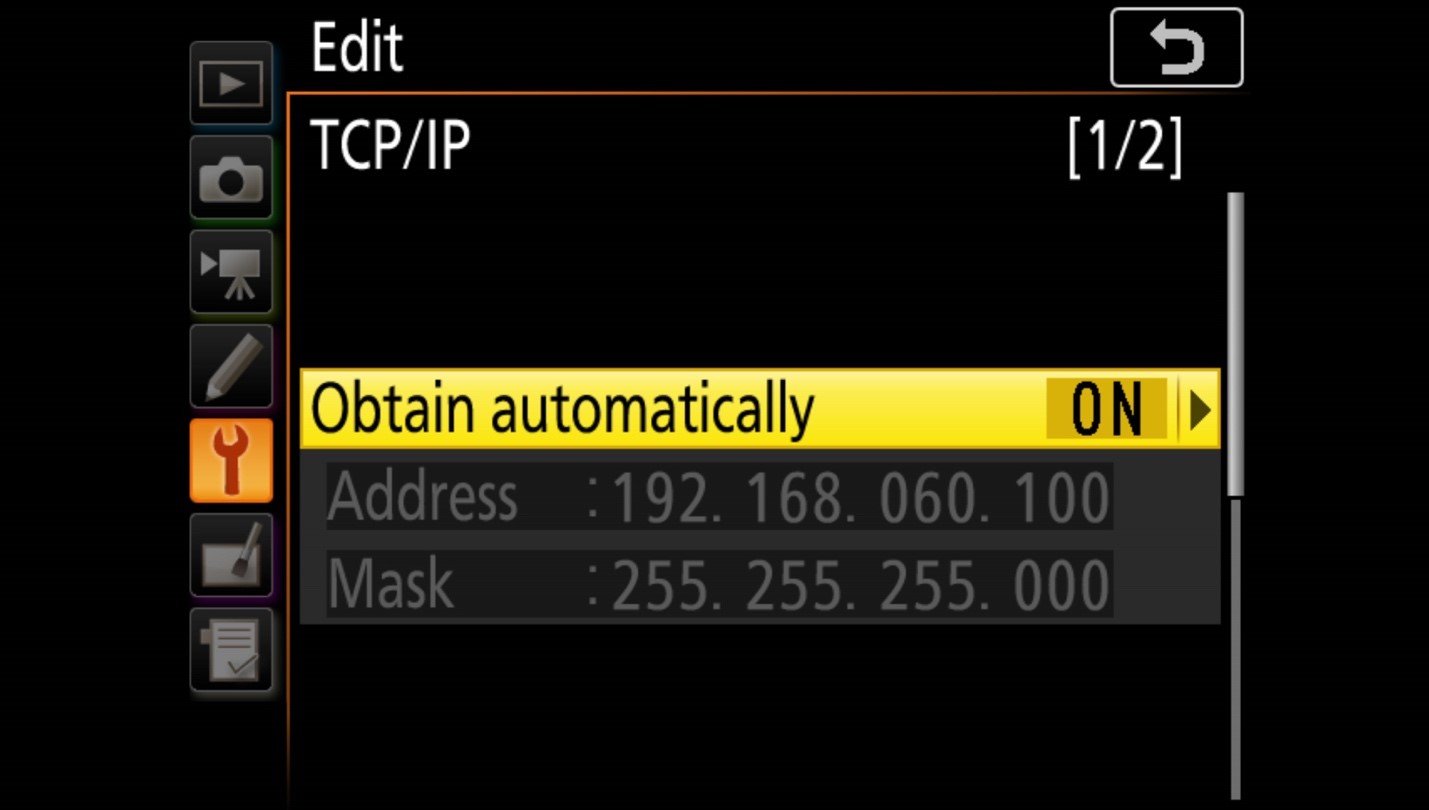
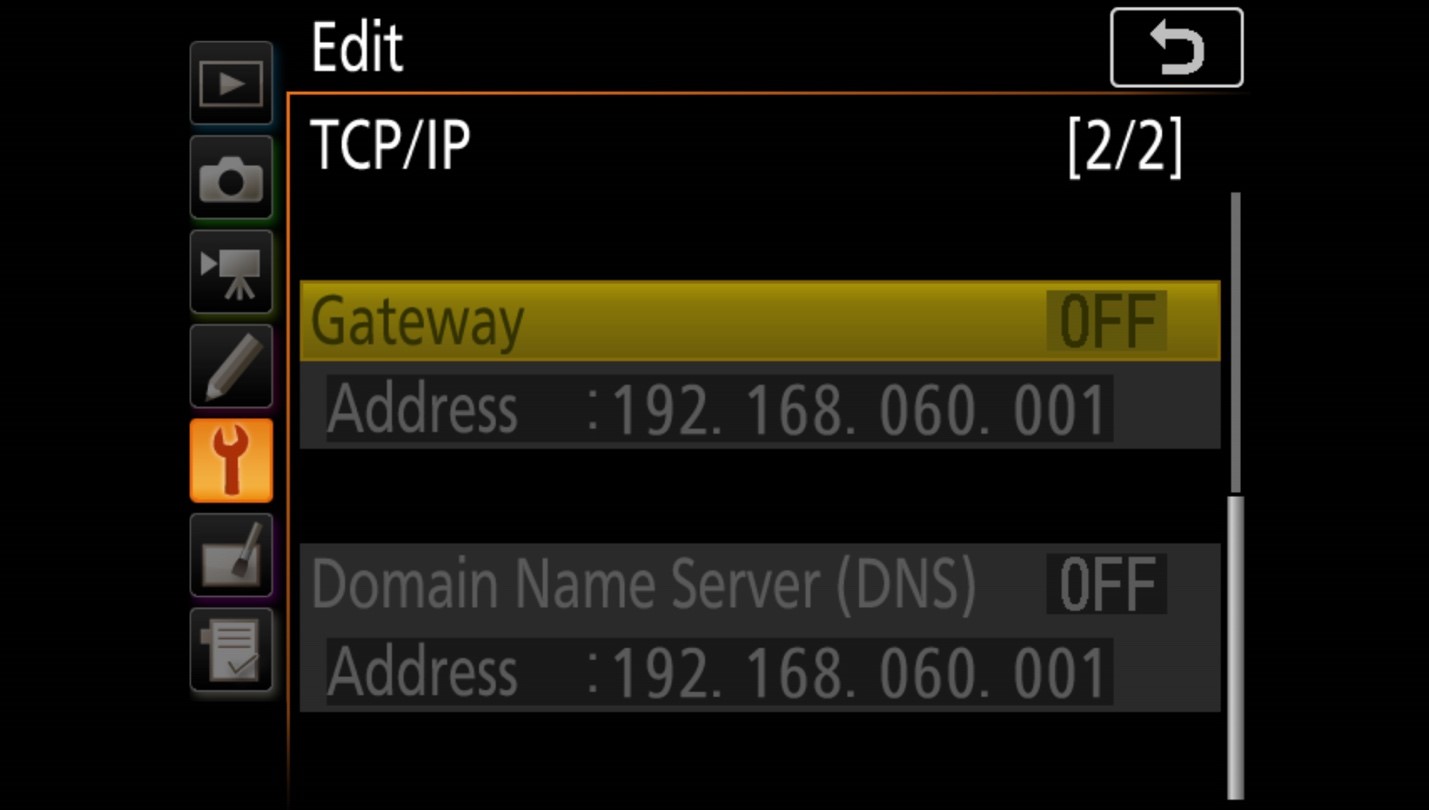
- In "FTP," enter 192.168.60.1 for the "Address." For the "Folder," enter the name of the folder you created when setting up the My Cloud app. Leave "Port" as the default "21."
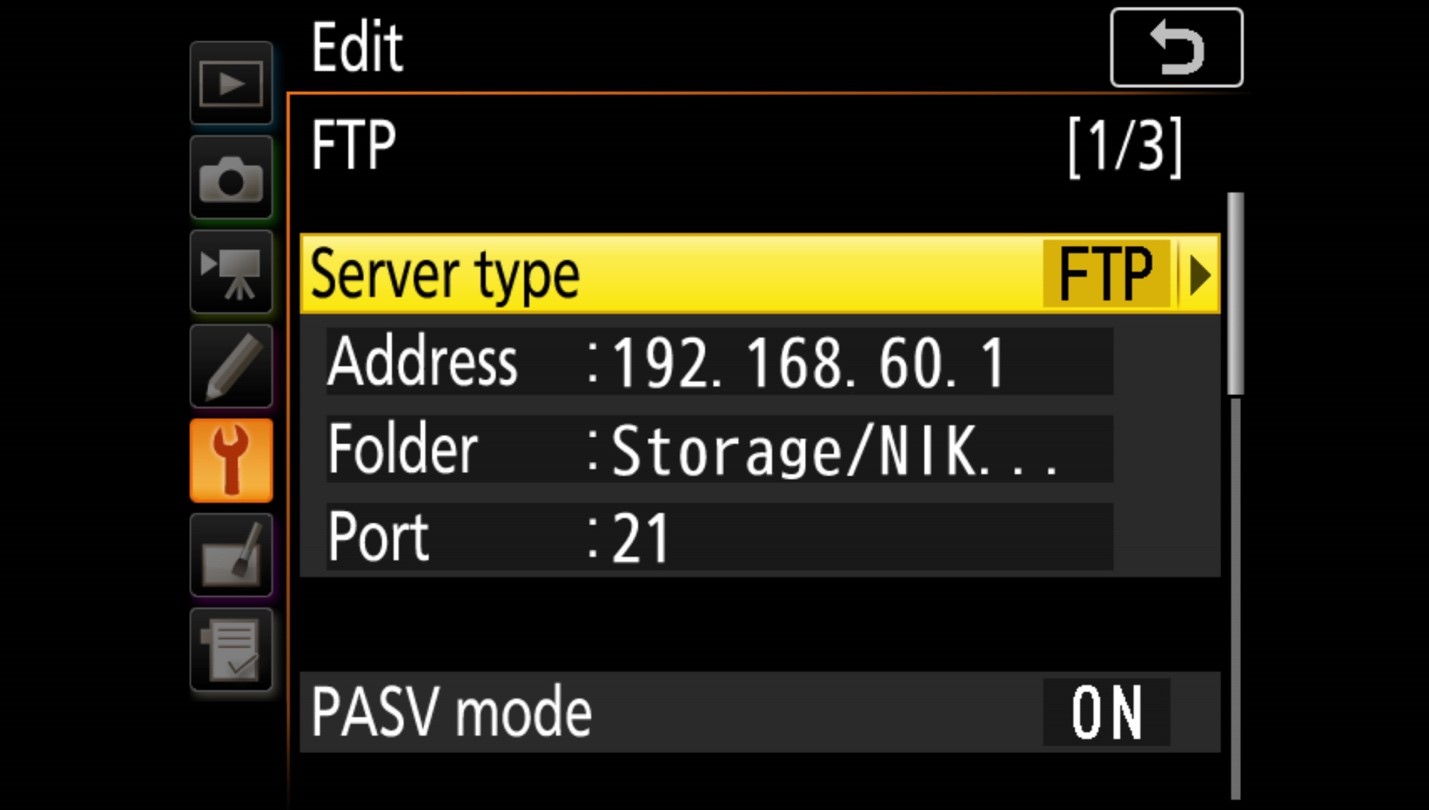
"Anonymous login" should be set to "ON".
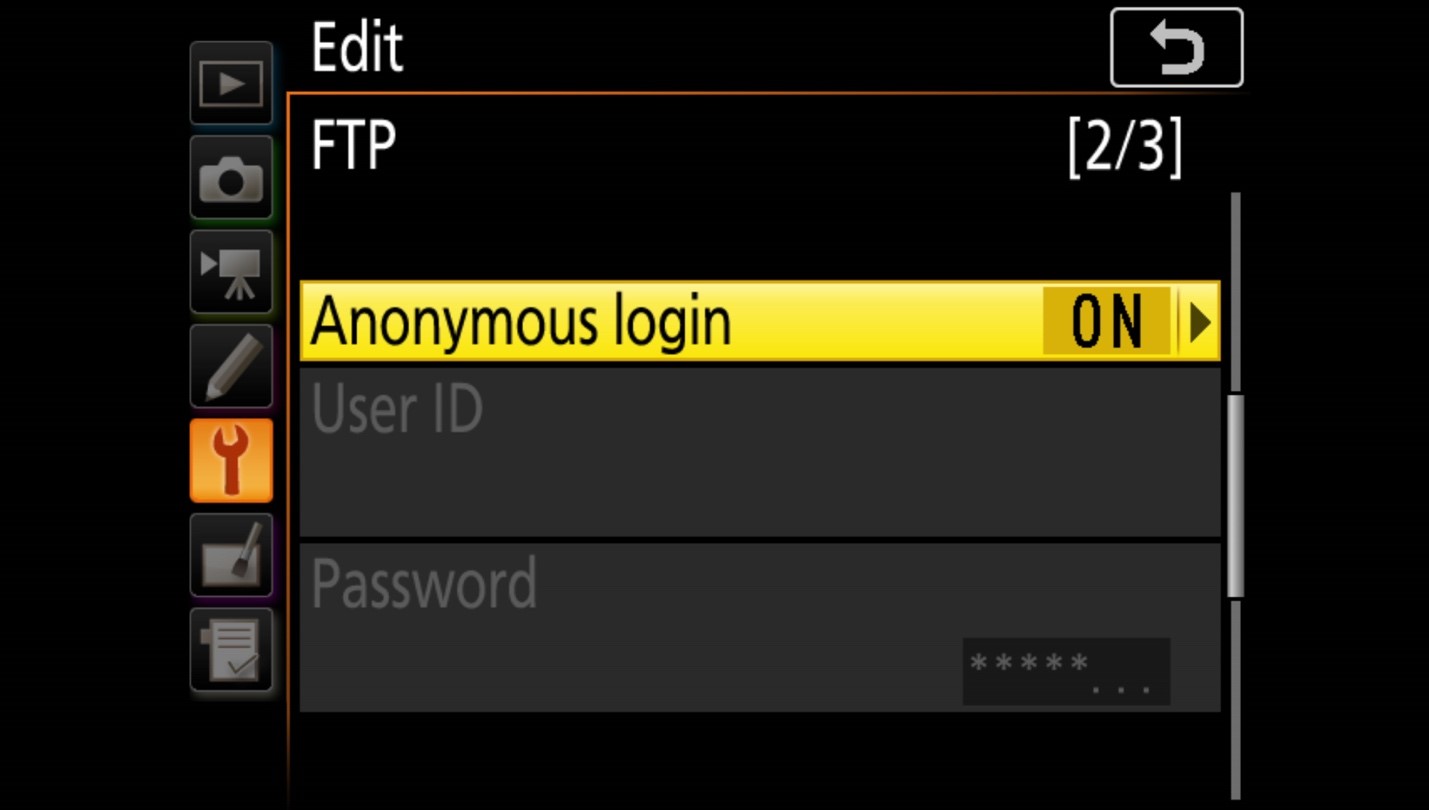
"Proxy server" should be set to "OFF."
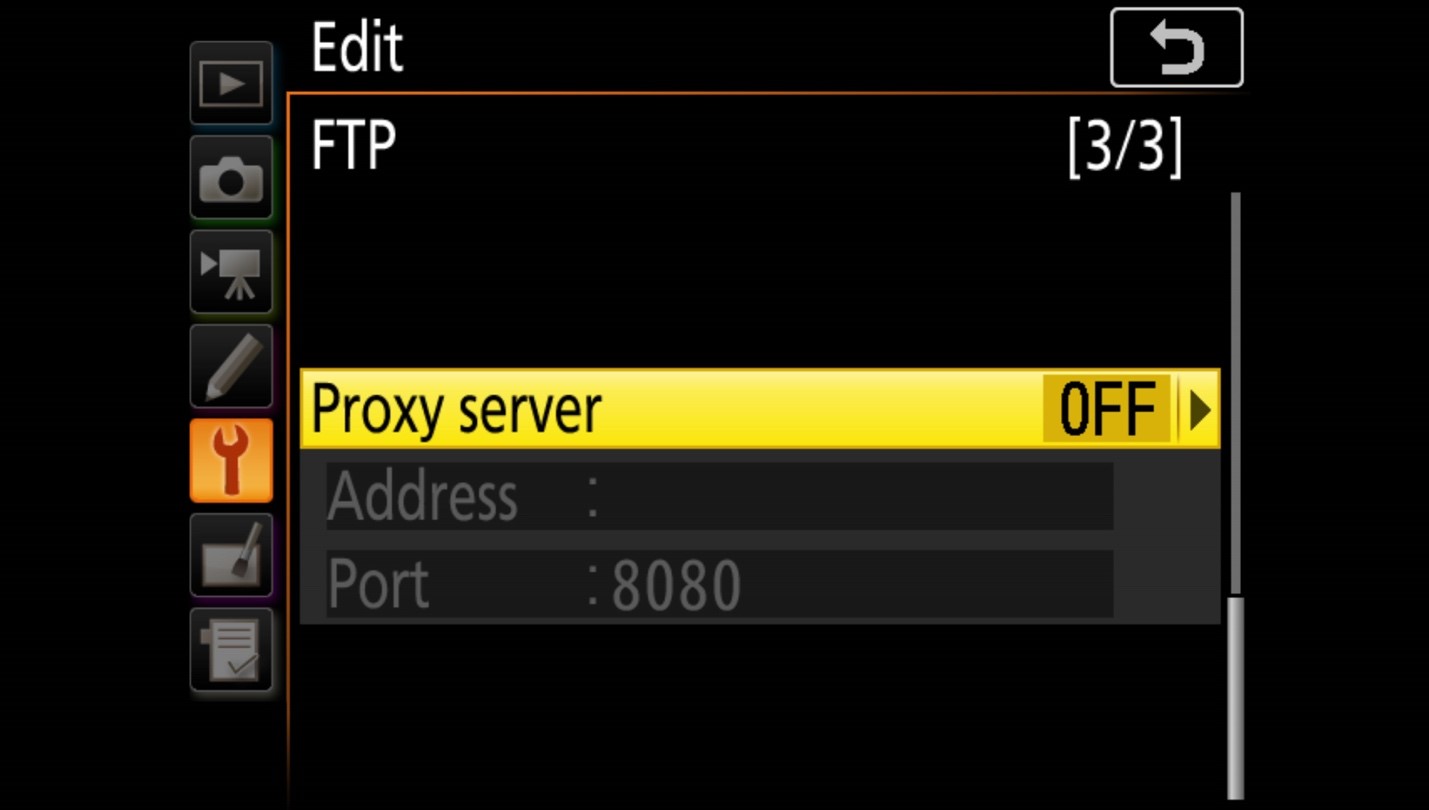
- Tap the back arrow twice to return to the original screen.
- Push the menu button and navigate to the Setup Menu (with an icon of a wrench).
-
Compatibile Nikon adapters
Nikon Wireless Transmitters Cameras Nikon WT-4A #25365 Nikon WT-5A #27046 Nikon WD-6A #27161 Nikon WD-7A #27173 D3 ✓ D3S ✓ D3X ✓ D4 ✓ ✓ D4S ✓ ✓ D5 ✓ ✓ D300 ✓ D300S ✓ D500 ✓ * ✓ D700 ✓ D750 ✓ ✓ * ✓ D7000 ✓ ✓ D7100 ✓ D7200 ✓ ✓ * ✓ D800 ✓ ✓ D800E ✓ ✓ D810 ✓ * ✓ D810A ✓ ✓ * ✓ D850 ✓ * ✓ *Requires UT-1 Communication Unit adapter. (The WT-6 Wireless Transmitter plugs into the UT-1, and the UT-1 plugs into the camera.)
-
How to import multiple RAW images into Adobe Lightroom CC from My Passport Wireless SSD or Pro
- Ensure the WD My Cloud app is installed on your iPhone, iPad or iPod Touch from the App Store and you have performed the standard drive setup
- Install the Adobe Lightroom CC app on your iPhone, iPad or iPod Touch from the App Store. Sign into your Adobe Creative Cloud account in the iOS Lightroom CC app on your mobile device. For more information on signing into Lightroom CC, click here.
- Look in Settings > Wi-Fi on your iPhone, iPad or iPod Touch to wirelessly connect your mobile device to the Wi-Fi network of your My Passport Wireless Pro or SSD. Additional help can be found in step 3 in this short guide on our Support site.
- Open Lightroom CC on your iOS device, select an album (such as "All Photos"), and tap on the three dots in the upper right.
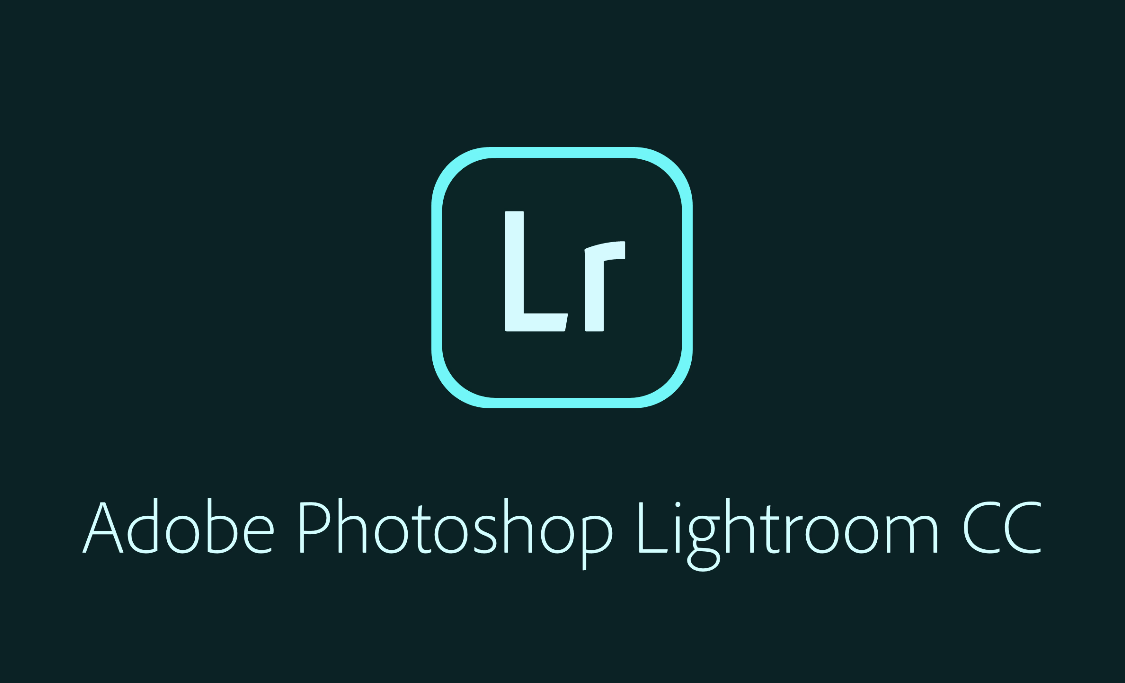
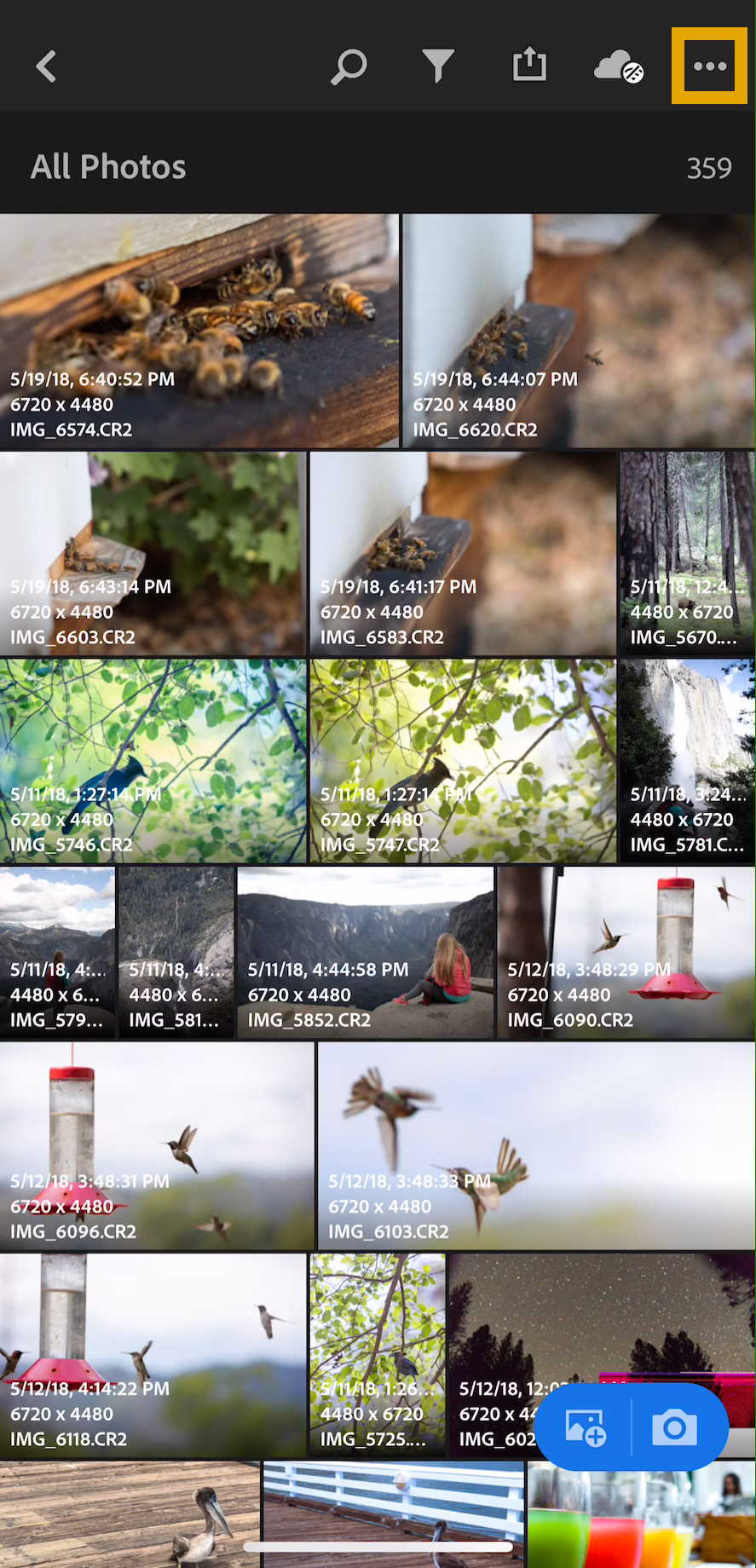
- Tap "Add Photos" and then select "Files."
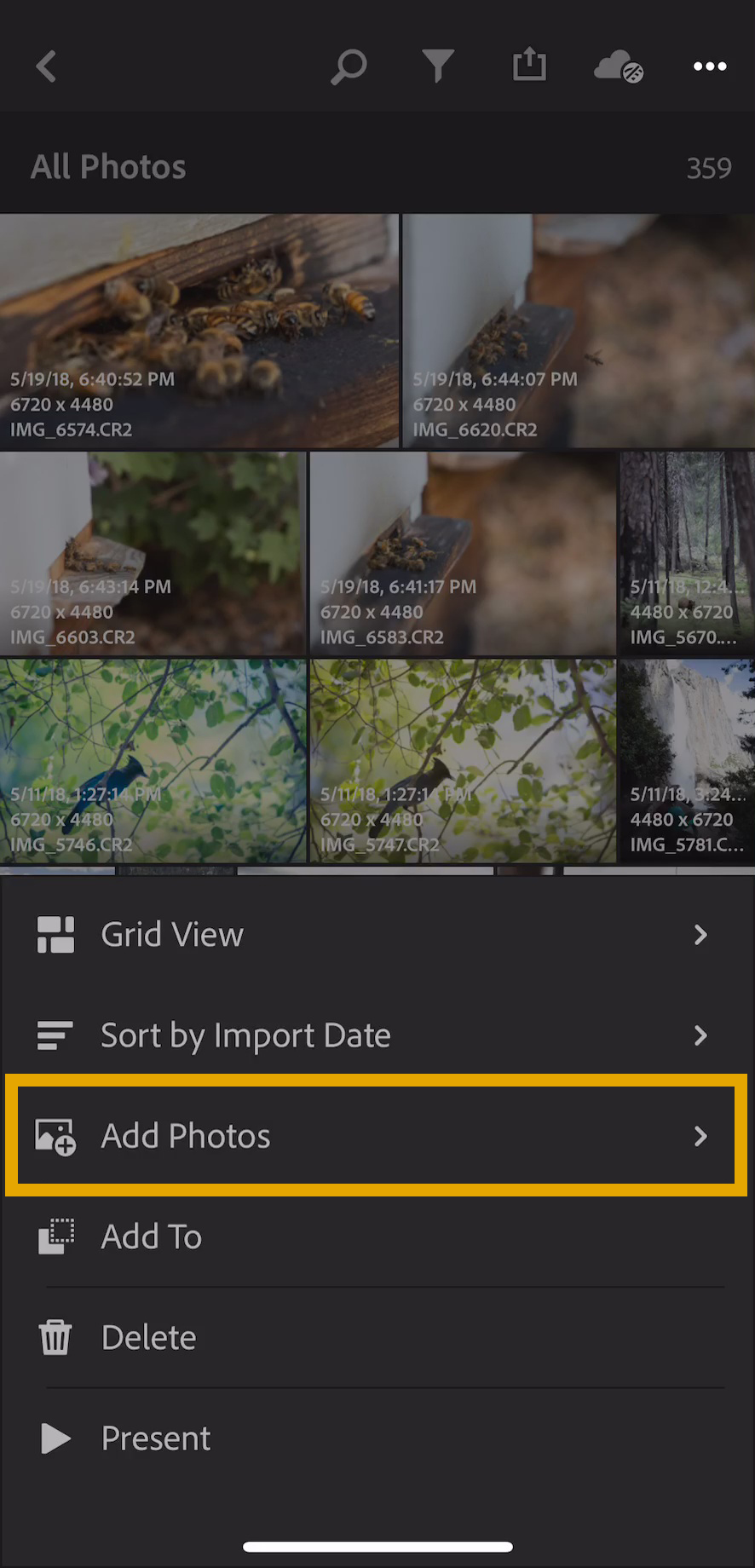
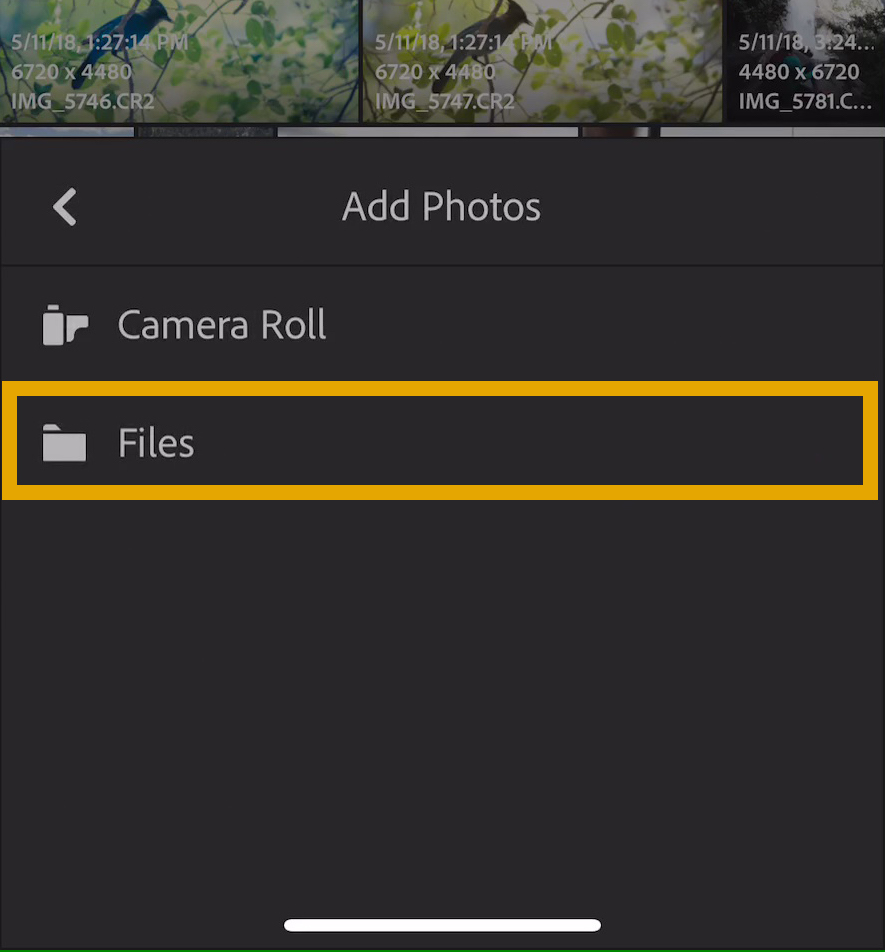
- If this is your first time using the My Cloud app within Files, you may not see it in your list of Storage Locations. Tap "More Locations," then find and set the "My Cloud" switch to the "On" position.
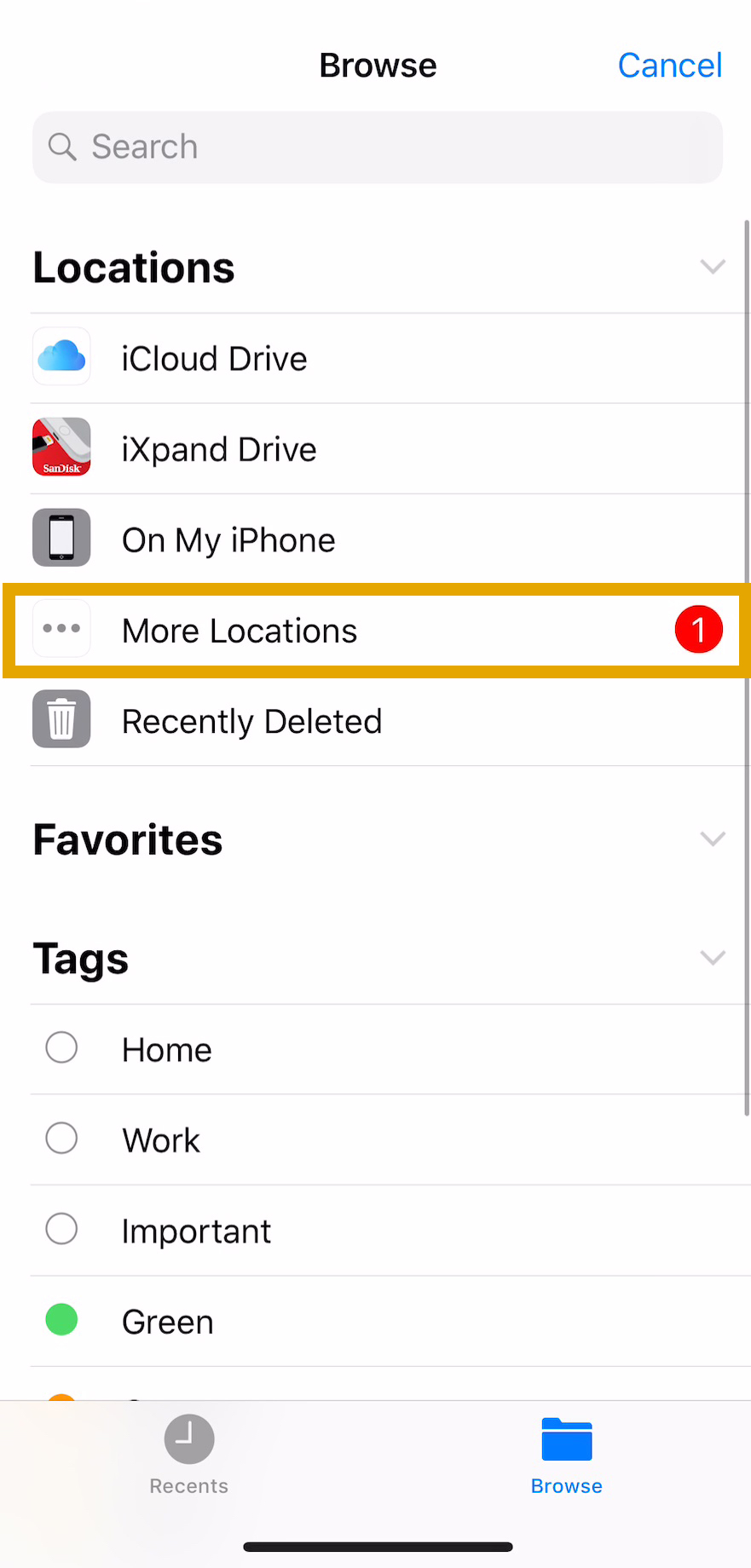
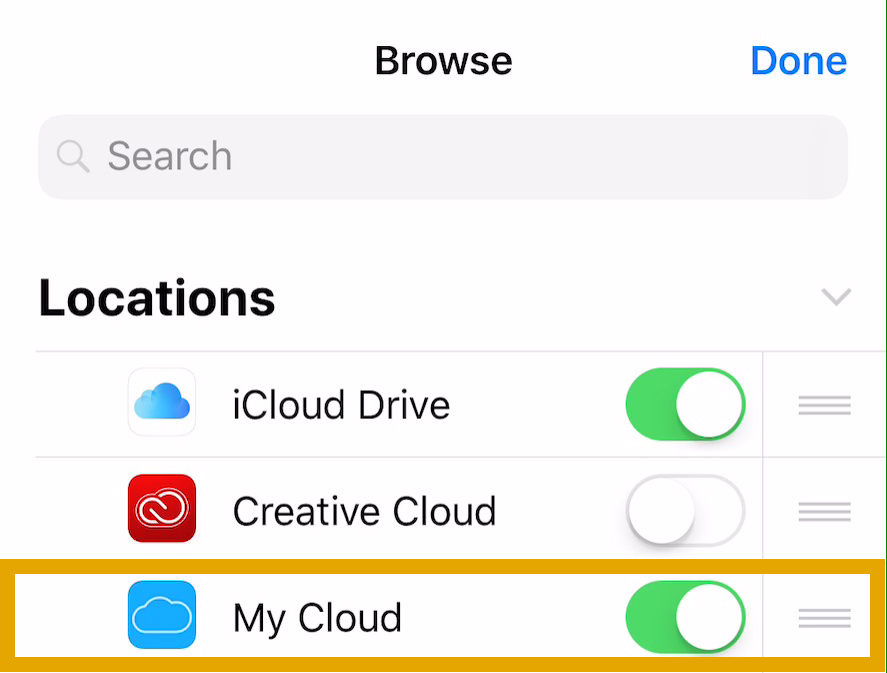
- Tap on "My Cloud," then tap "MyPassport," and then navigate to the photos you would like to import into Adobe Lightroom CC.

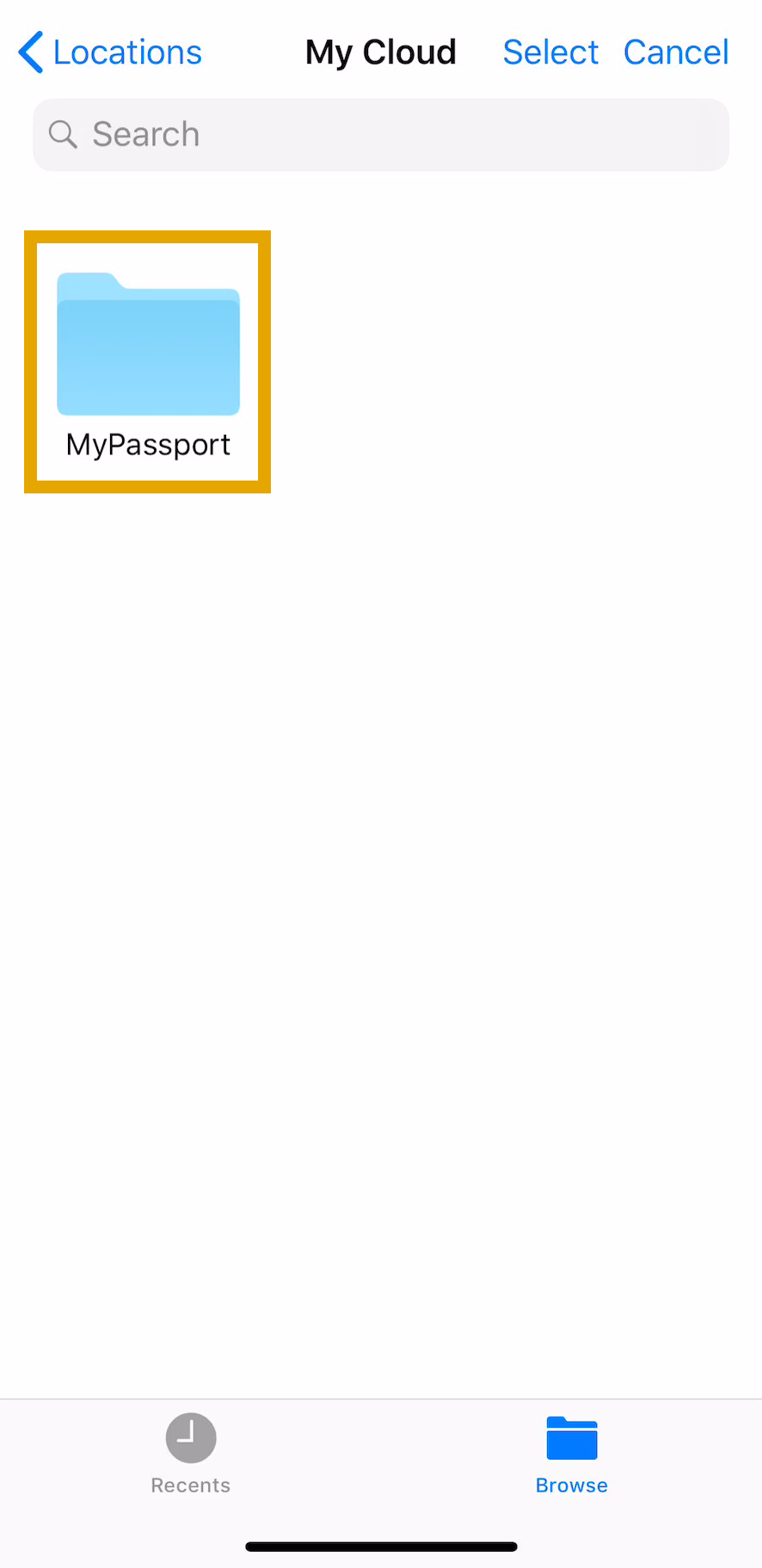
- Tap "Select" in the upper right, then select the RAW images you would like to import to Lightroom CC. Once you have finished making your selections, tap "Open."

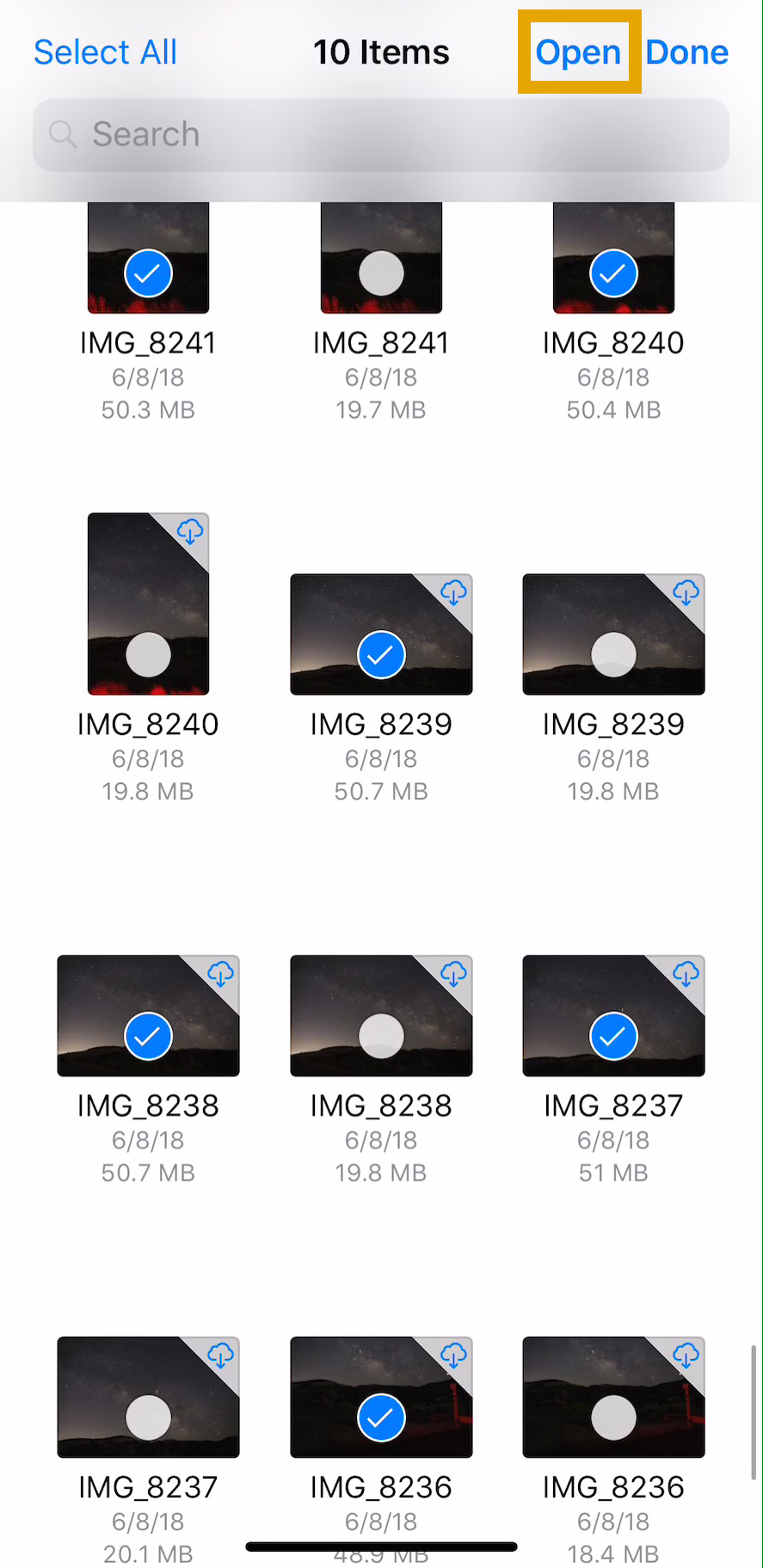
- Photos will then import into Adobe Lightroom CC.
NOTE: When importing multiple images, Lightroom CC may import (and alert to) only one image at a time. The remaining images from your selection will import in succession with no intervention required from the user.
Lightroom CC import speed depends on multiple factors such as iOS device connection speed to the My Passport Wireless, the size of the file, and the computational speed of your iOS device.
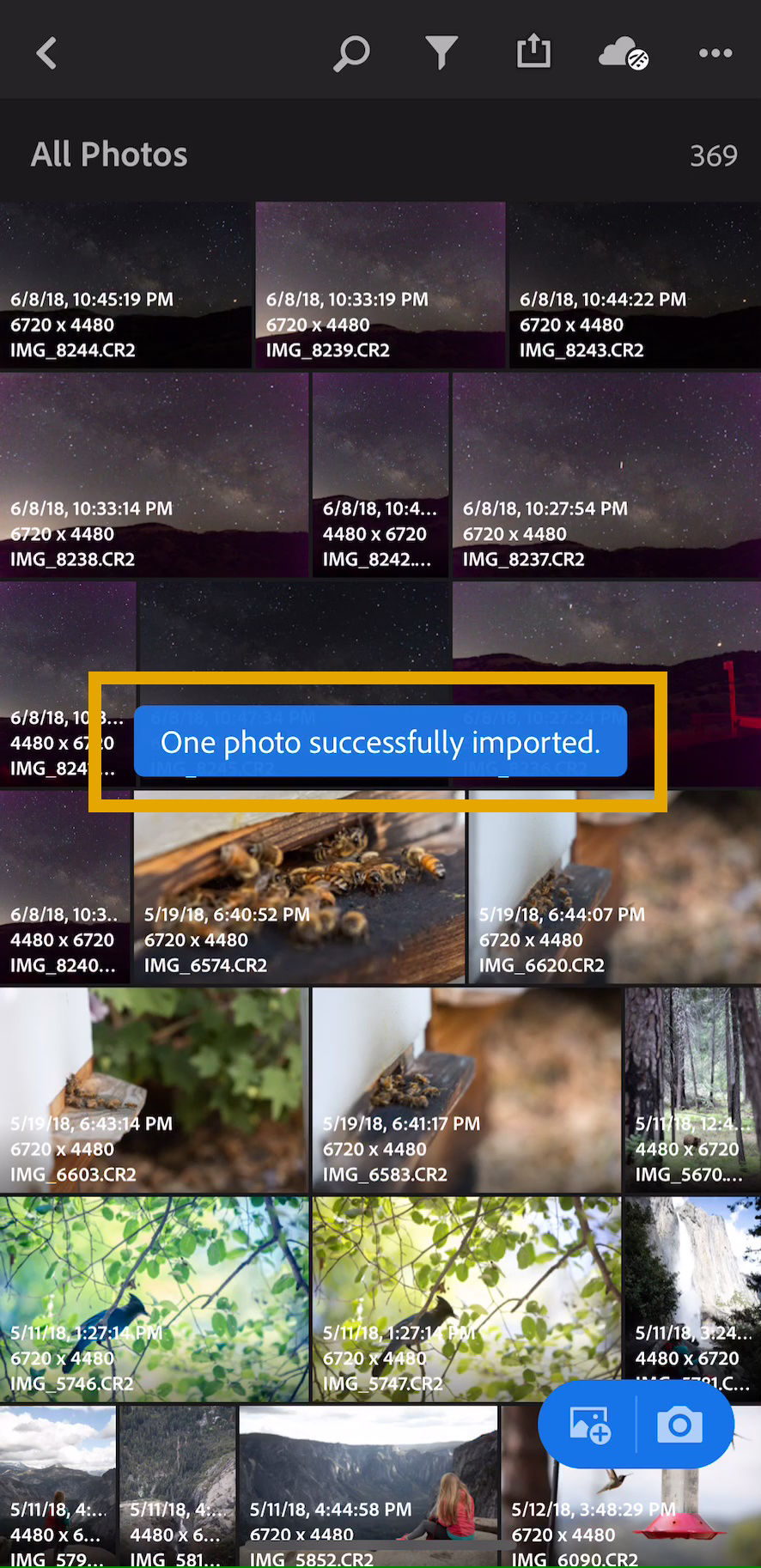
- Your images, and any edits you make, will sync between your iOS device and other platforms where you have installed and activated sync for Adobe Lightroom CC or Adobe Lightroom CC Classic.
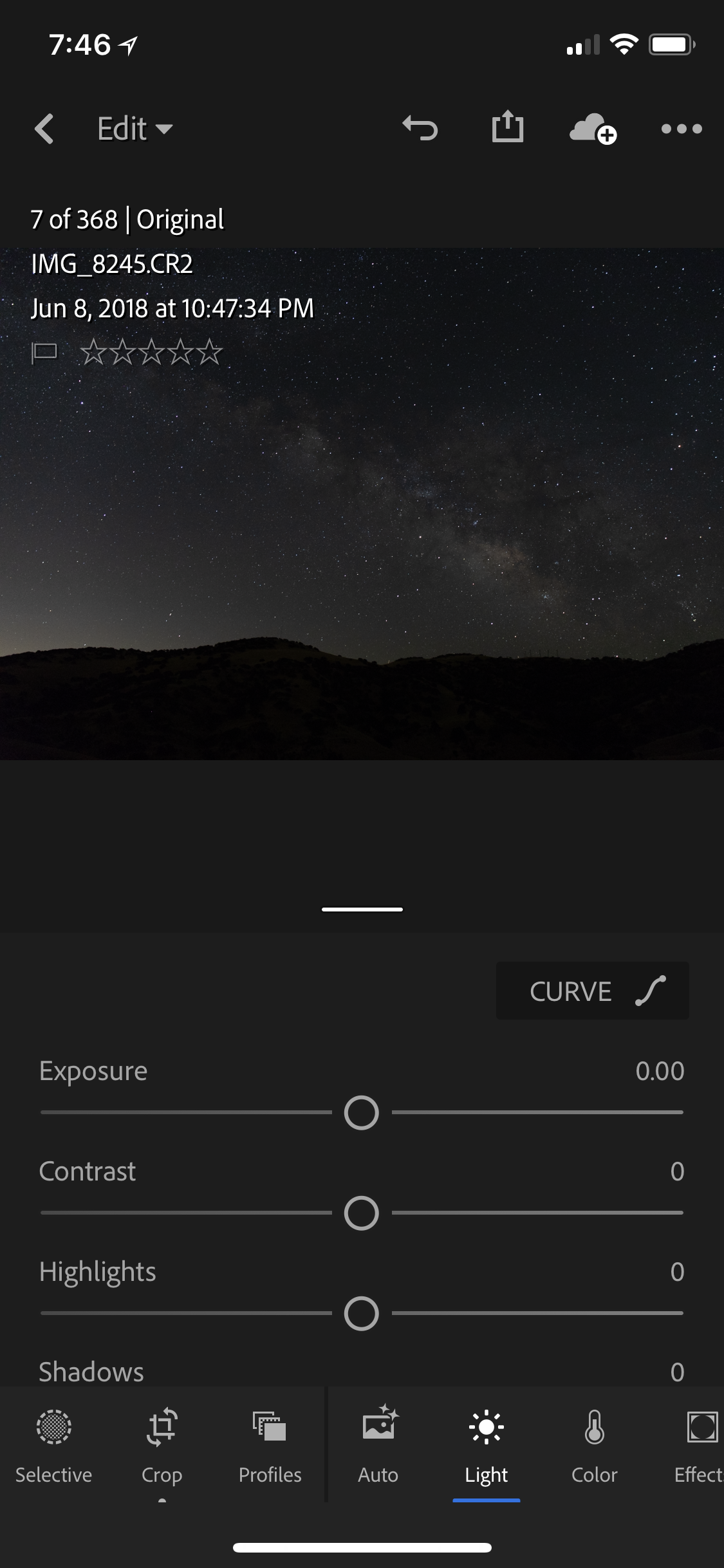
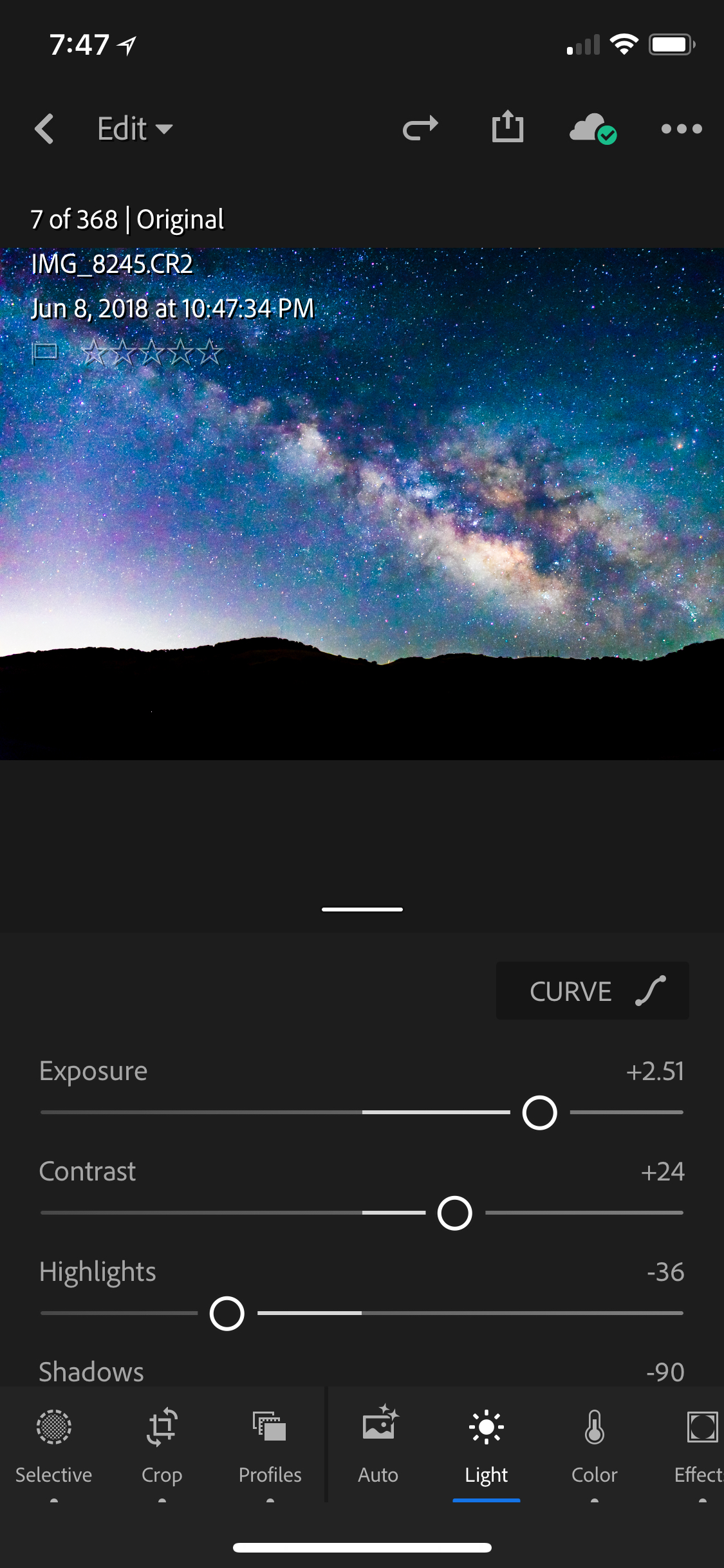
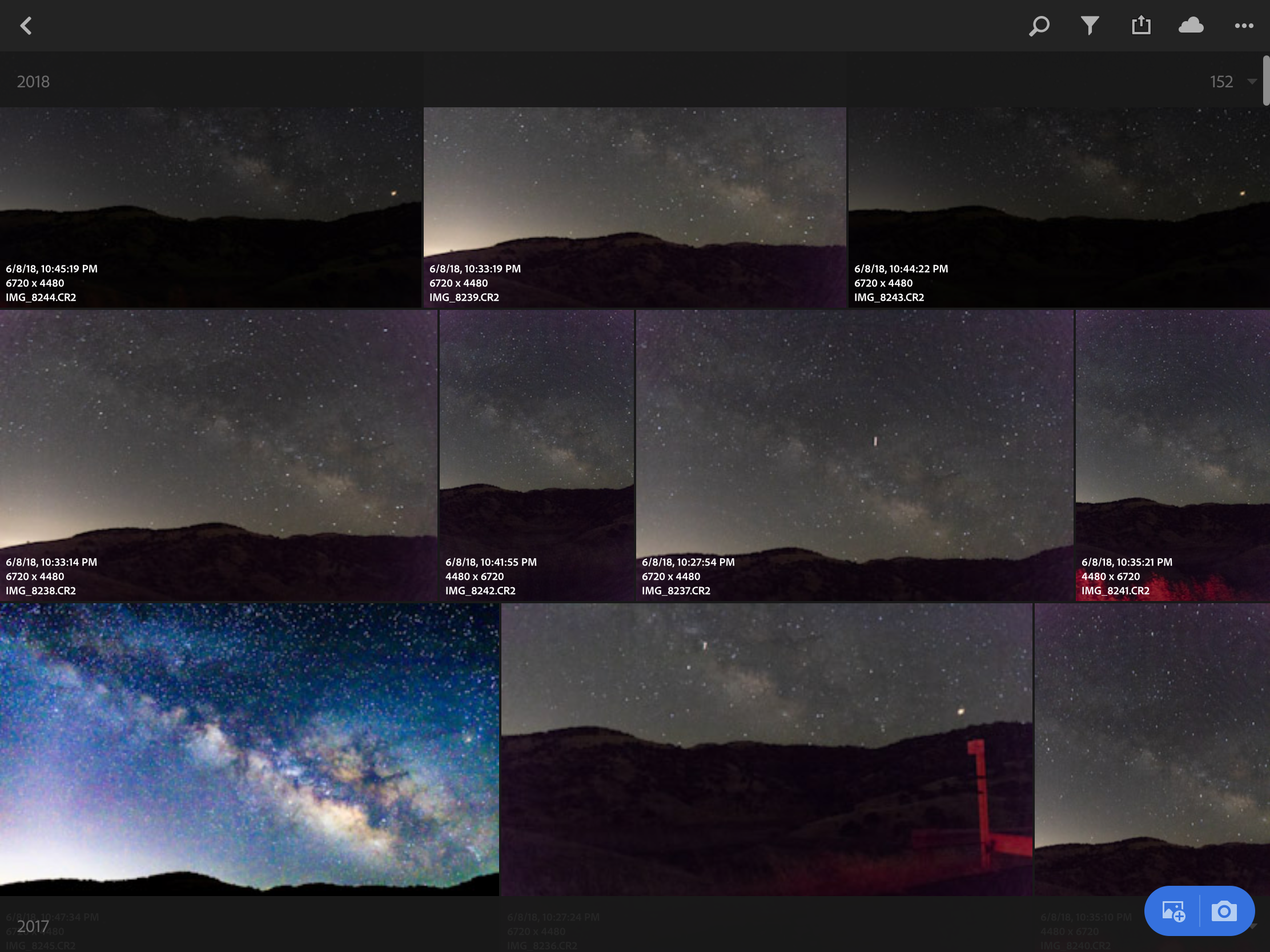
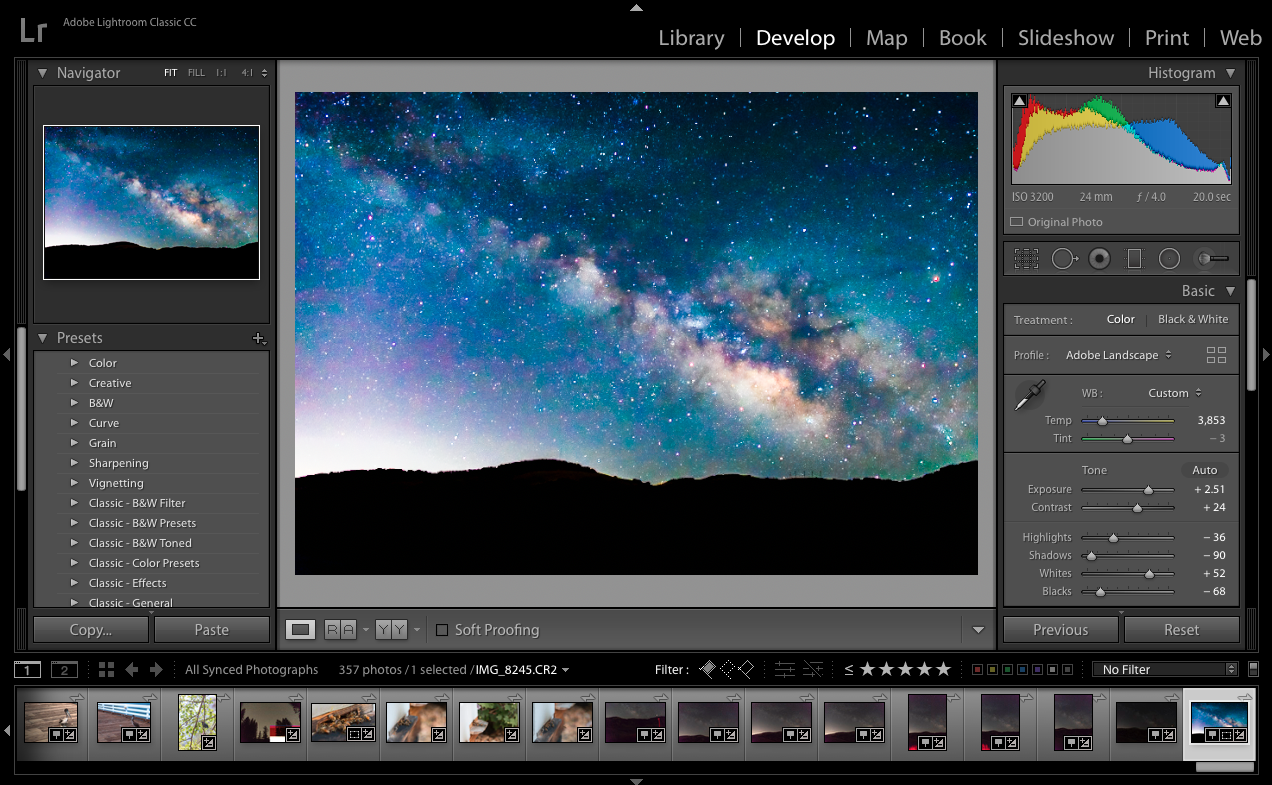
To learn more about Adobe Lightroom CC, please visit https://helpx.adobe.com/lightroom-cc/get-started.html
Common Questions:
-
How to set up your My Cloud Home
Watch this short video to learn how to:
- Set up My Cloud Home through a mobile web browser
- Set up My Cloud Home if device is not automatically found with your nine digit code
-
How to upload content from your mobile phone
Watch this short video to learn how to:
- Set up auto backup for your Camera Roll
- Manually upload content to your My Cloud Home
- Take a photo or video and save directly to your My Cloud Home device
- Download all your content from a public cloud service (Dropbox, Box, One Drive, etc.) to your My Cloud Home device
- Transfer all the content from your current My Cloud to the new My Cloud Home
- Plug in a USB storage device and copy content to your My Cloud Home
-
How to centralize all your content
Watch this short video to learn how to:
- Download all your content from a public cloud service (Dropbox, Box, One Drive, etc.) to your My Cloud Home device
- Transfer content from your current My Cloud to your new My Cloud Home device
- Use MyCloud.com to upload content
-
How to share content
Watch this short video to learn how to:
- Share a photo or file with your friends and family using the mobile app, the MyCloud.com, or the Desktop app
-
How to add users
Watch this short video to learn how to:
- Add friends and family members to your device for their own private space
- Manage users from your mobile phone
-
How to help secure your device
Watch this short video to learn how to:
- Set up a Passcode and Touch ID on your mobile app
- General pointers on helping to keep your device secure
© 2020 Western Digital Corporation or its affiliates. All rights reserved.
Backing Up to an External With My Could
Source: https://learn.mycloud.com/
0 Response to "Backing Up to an External With My Could"
إرسال تعليق